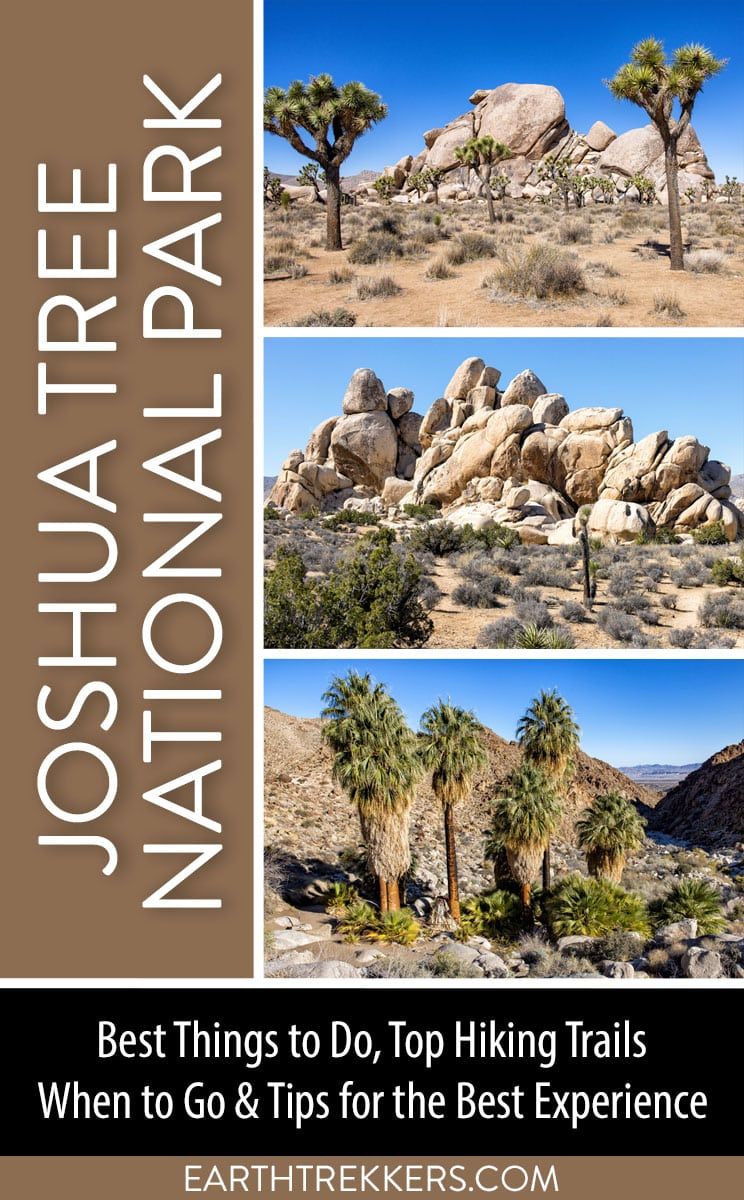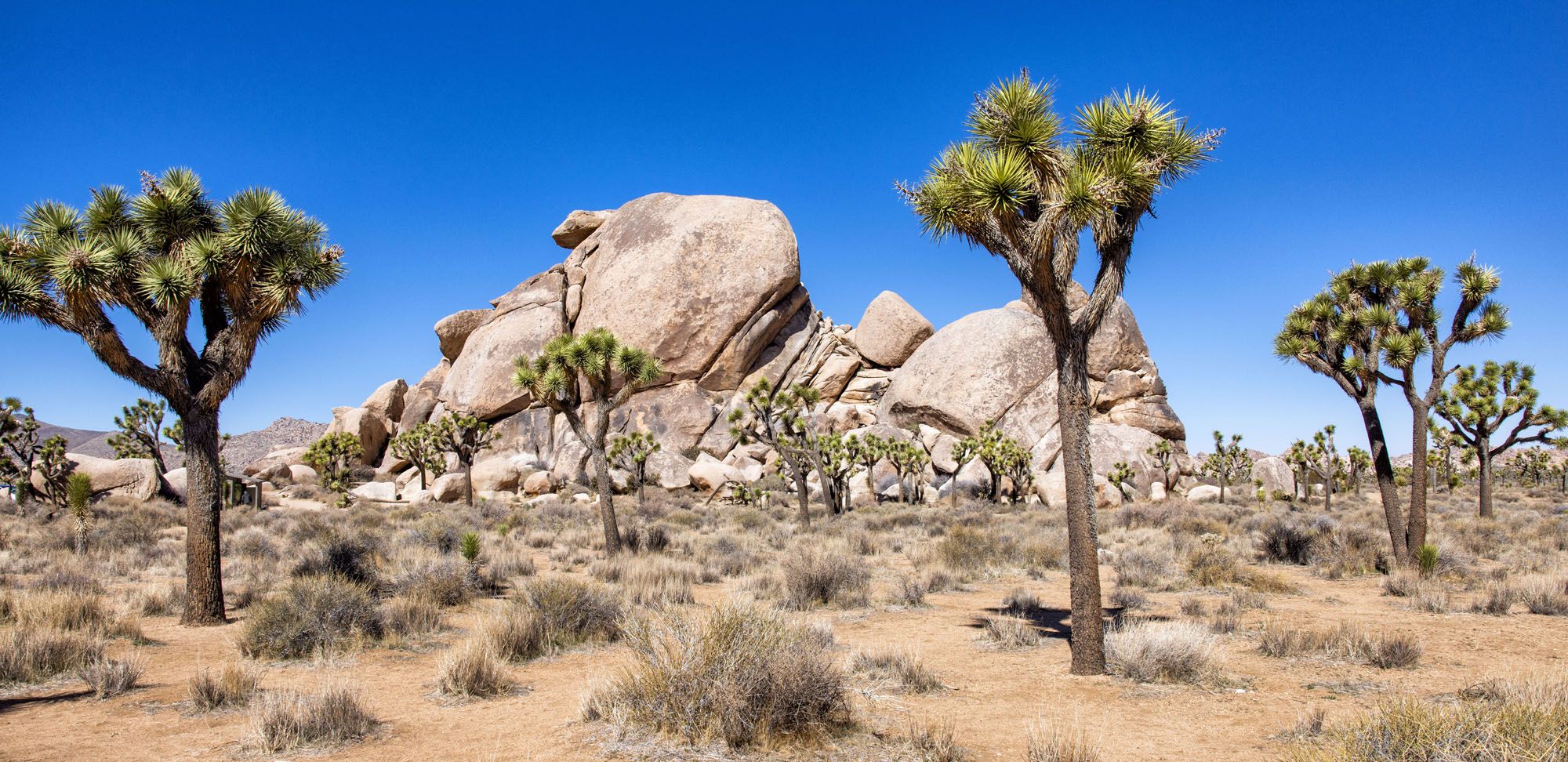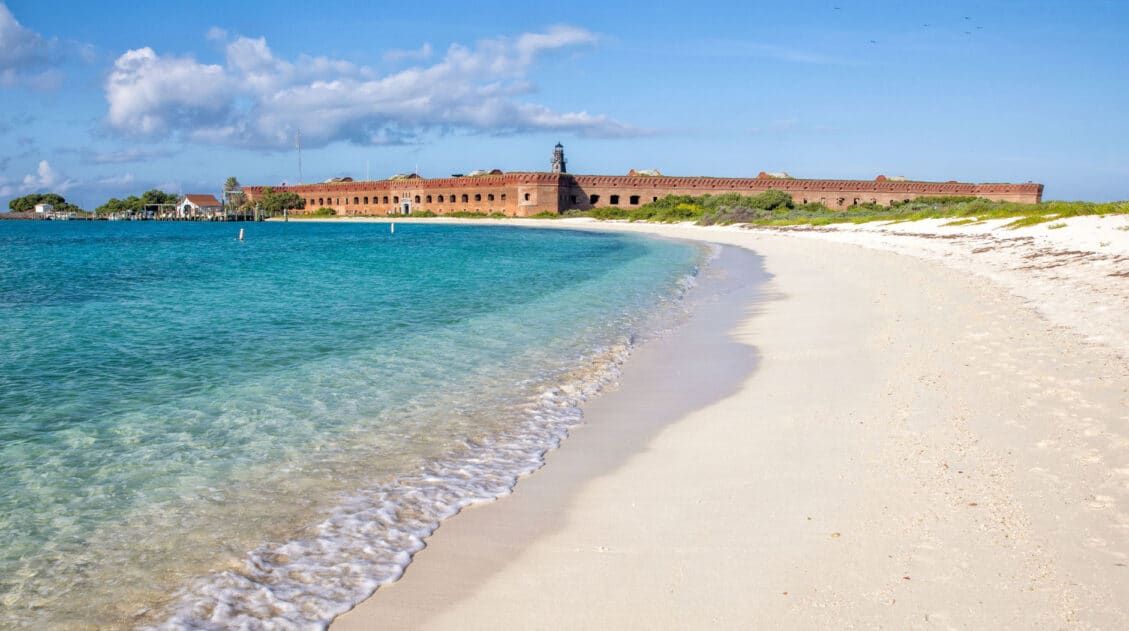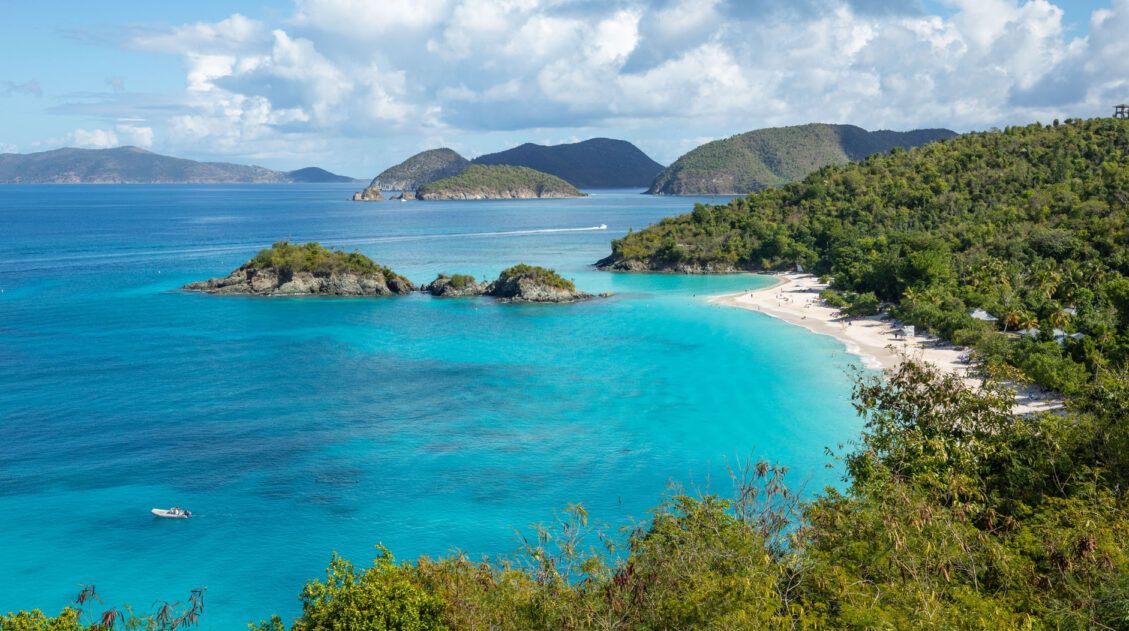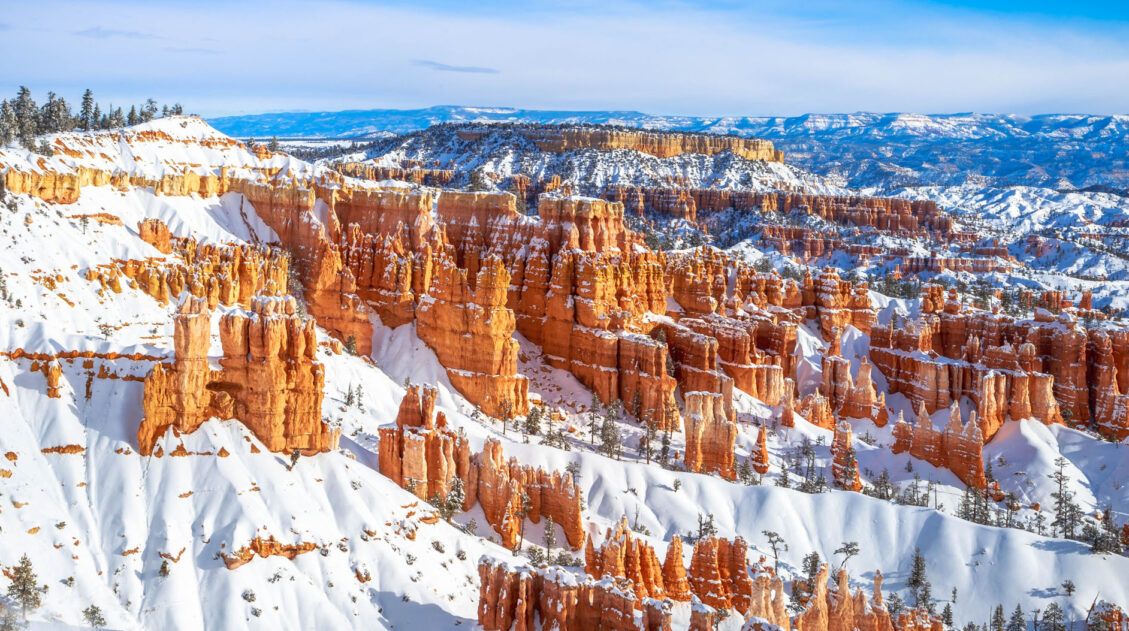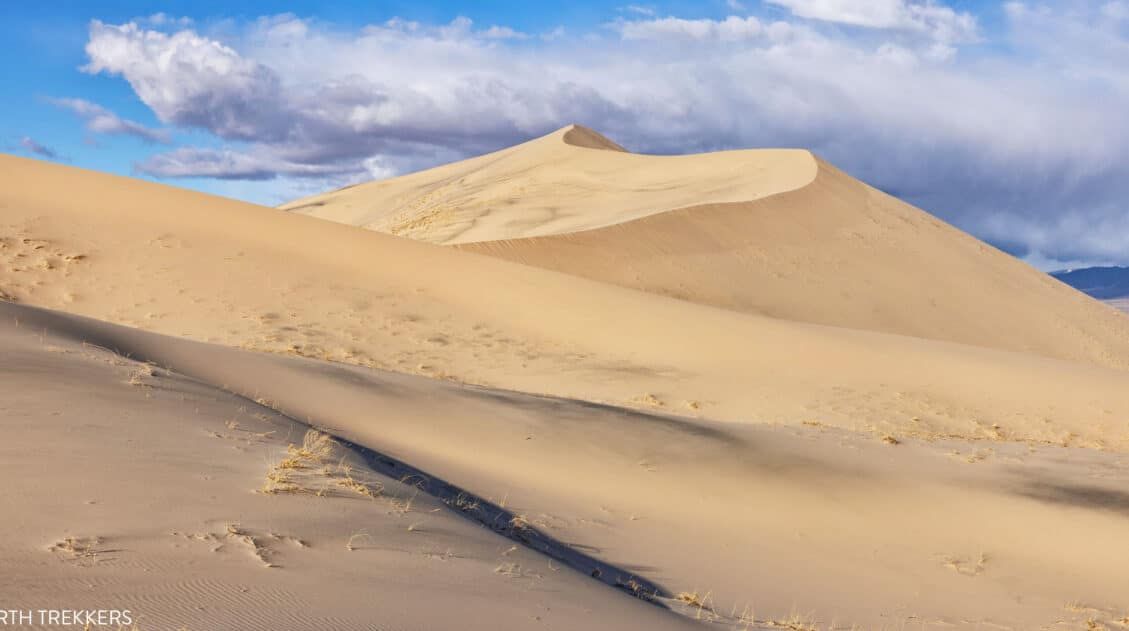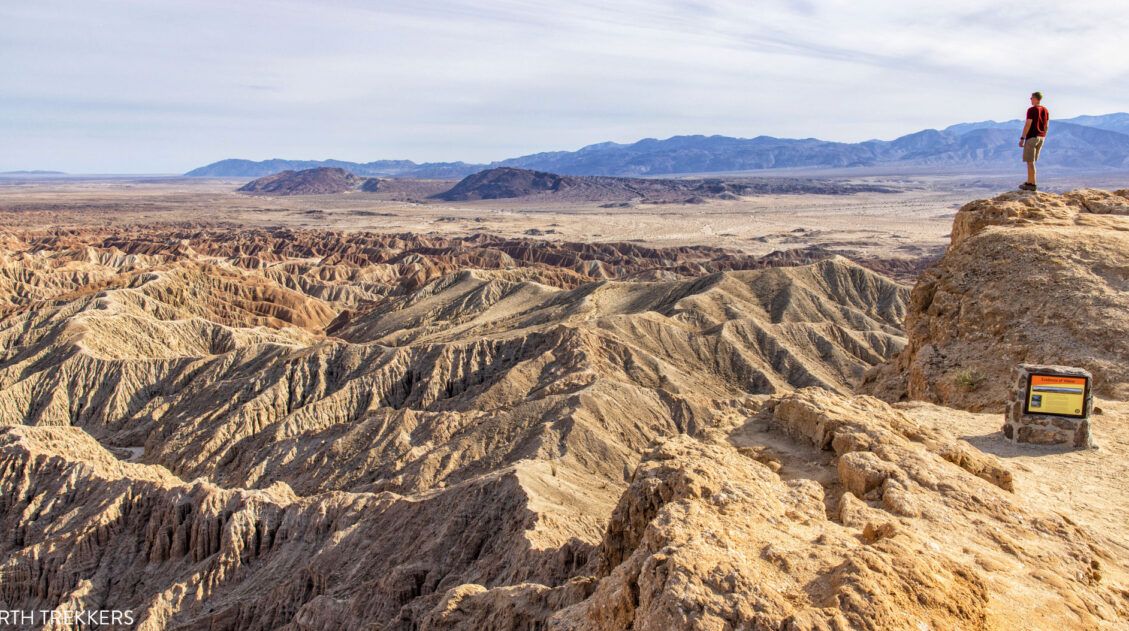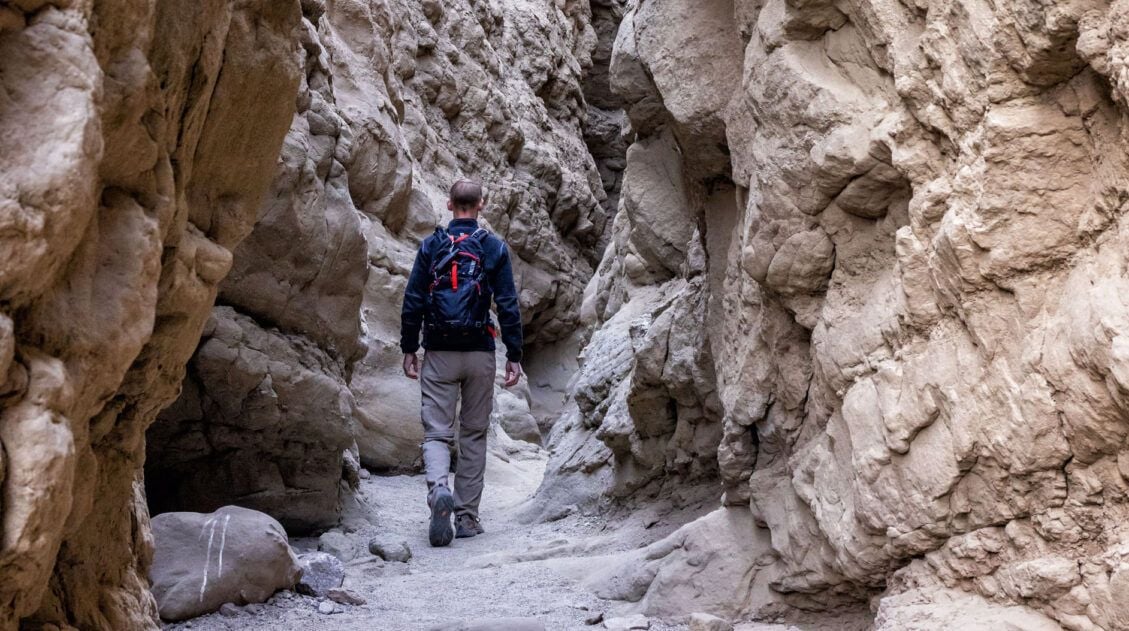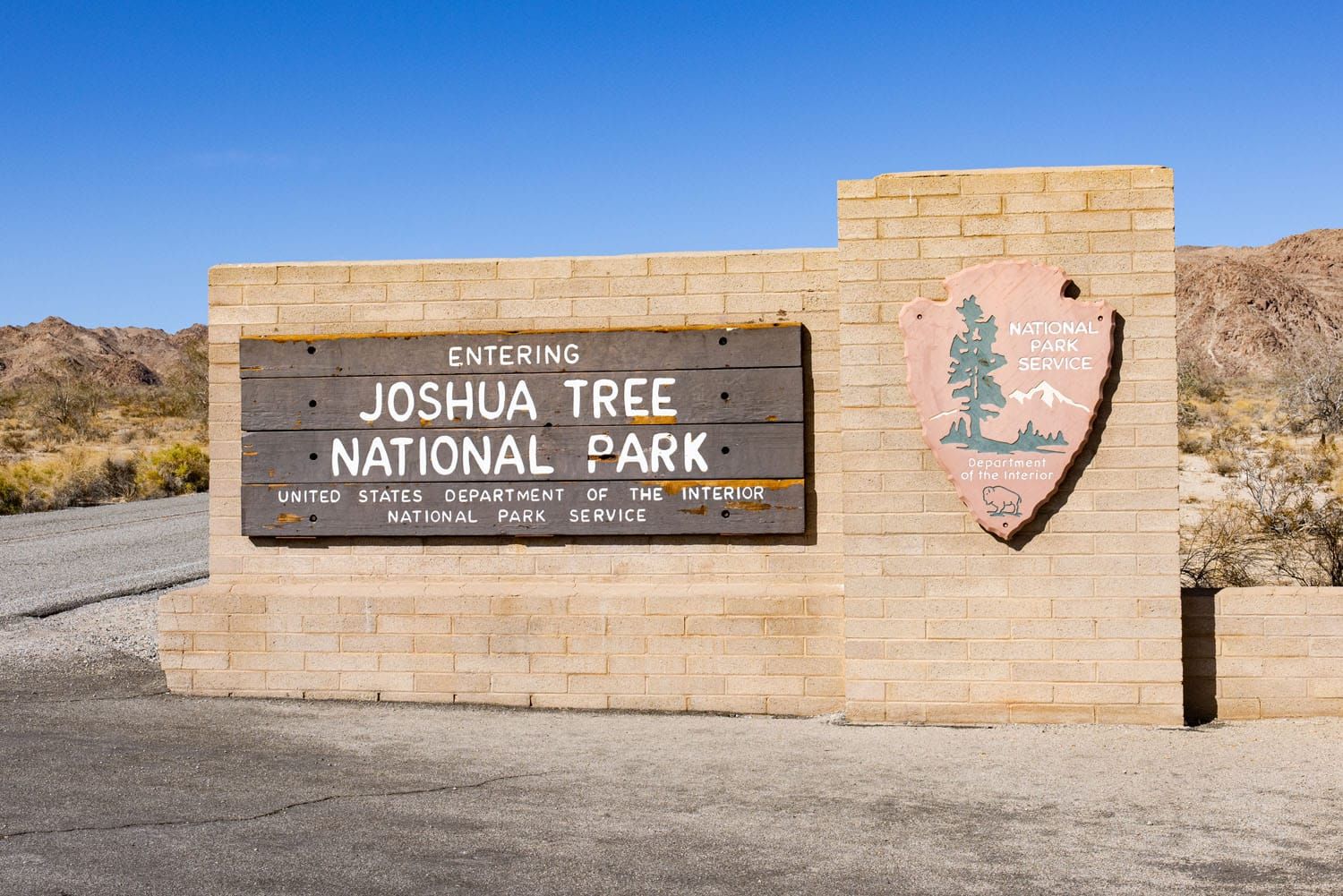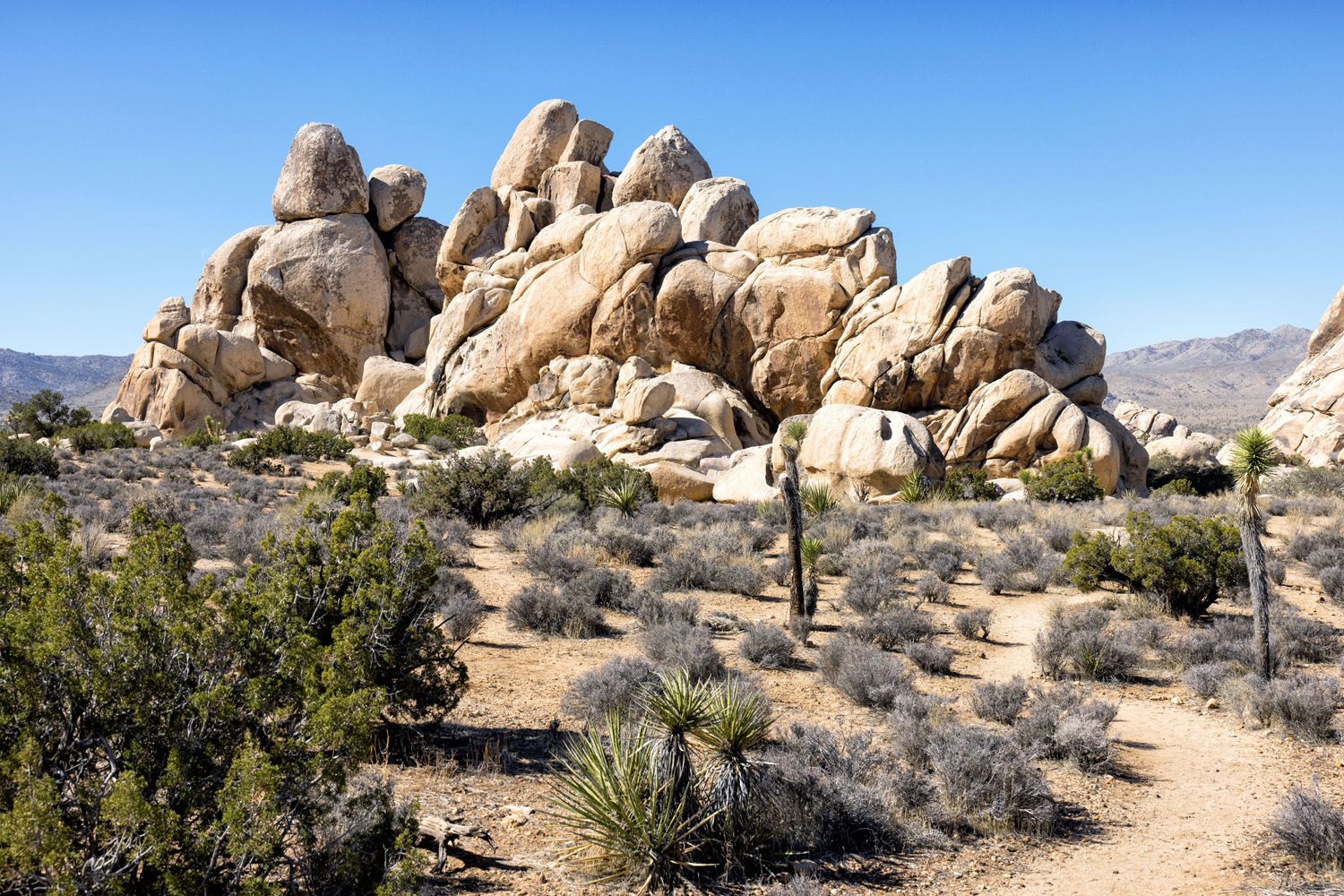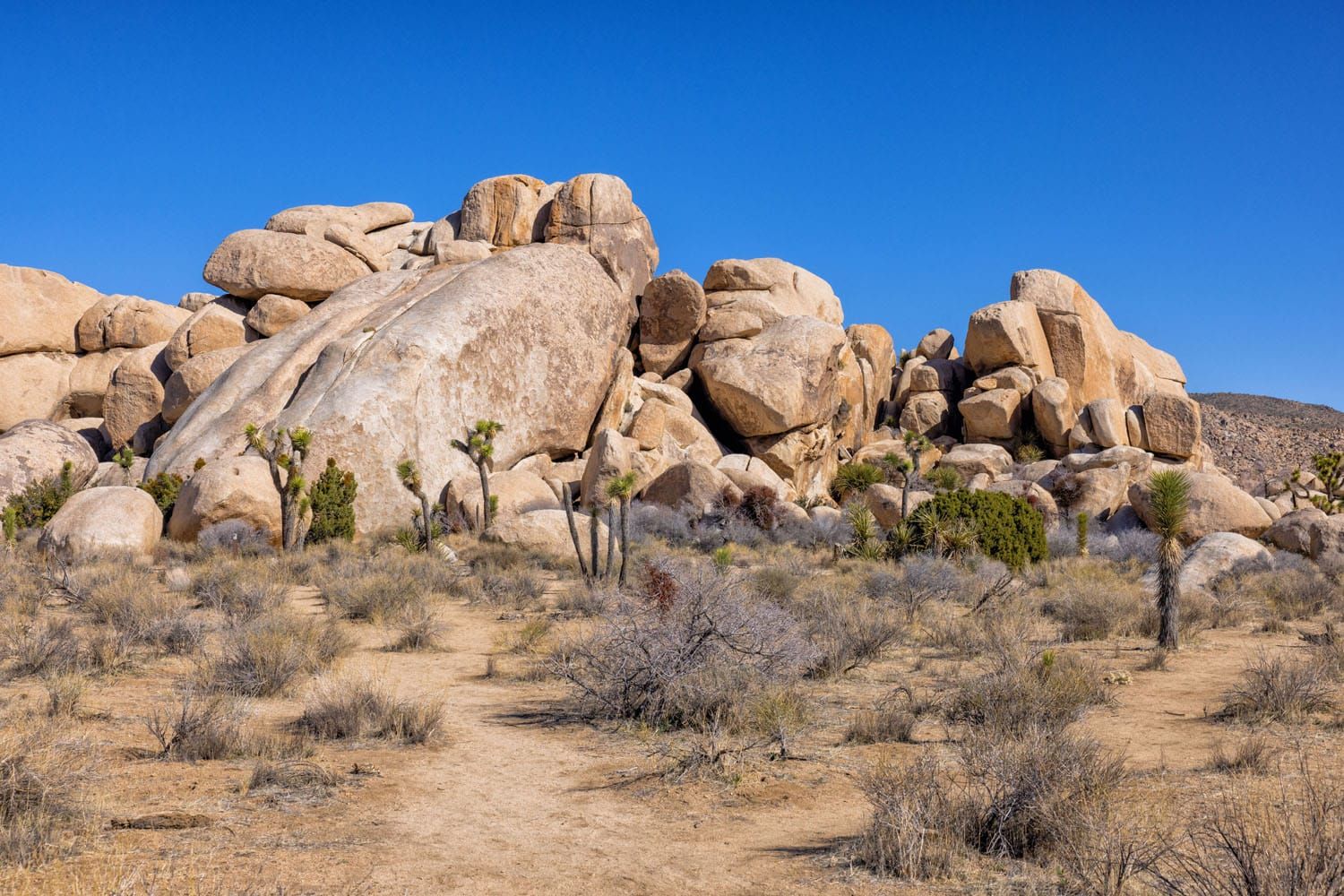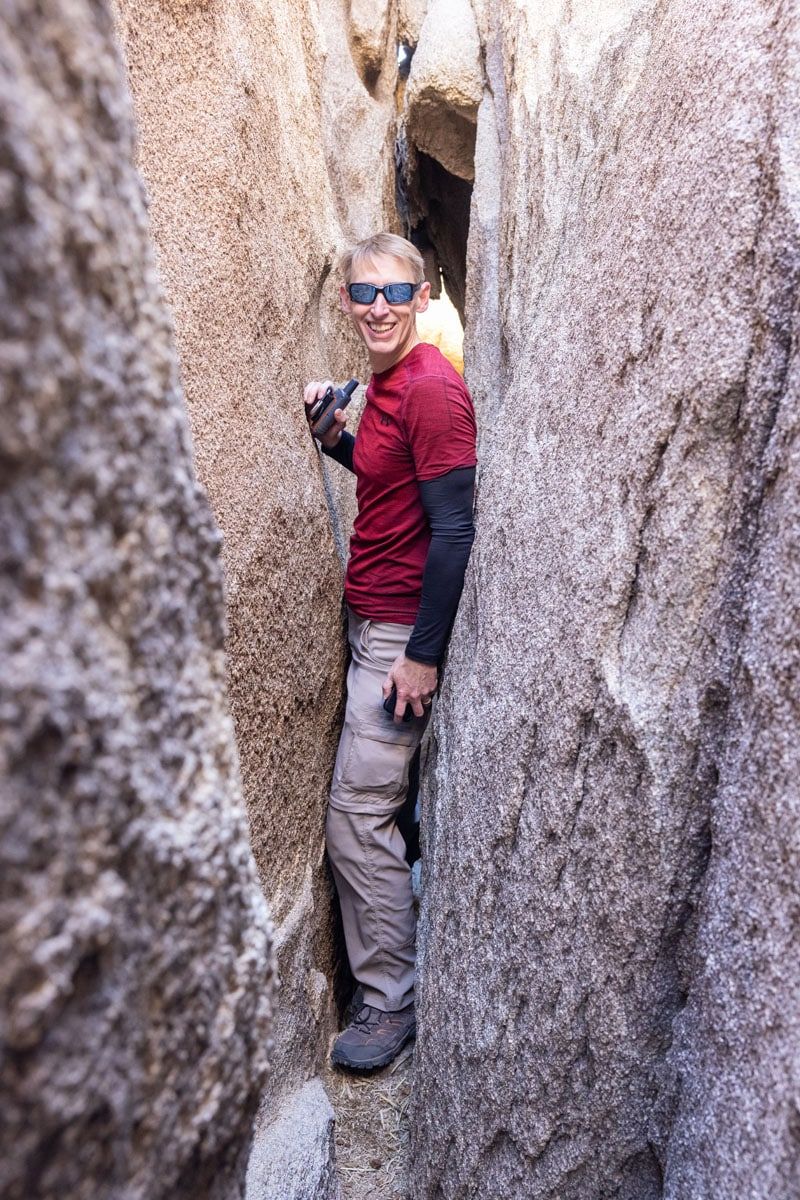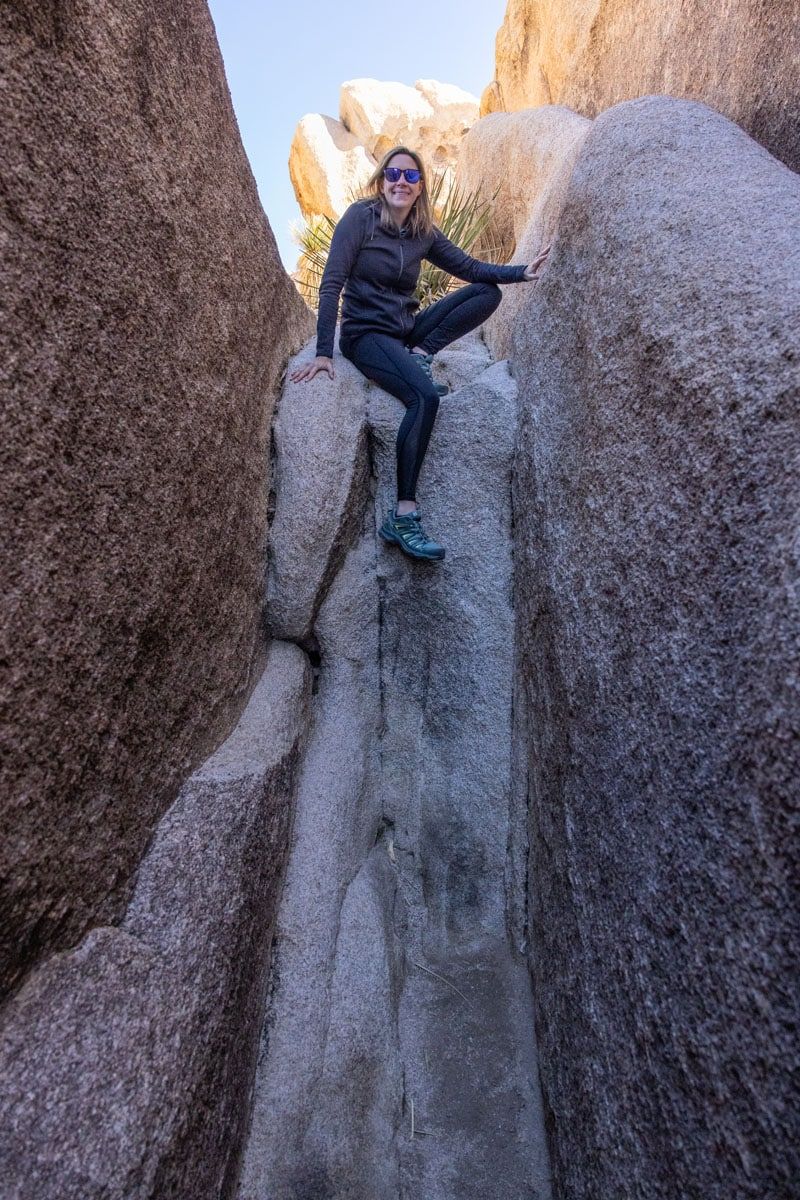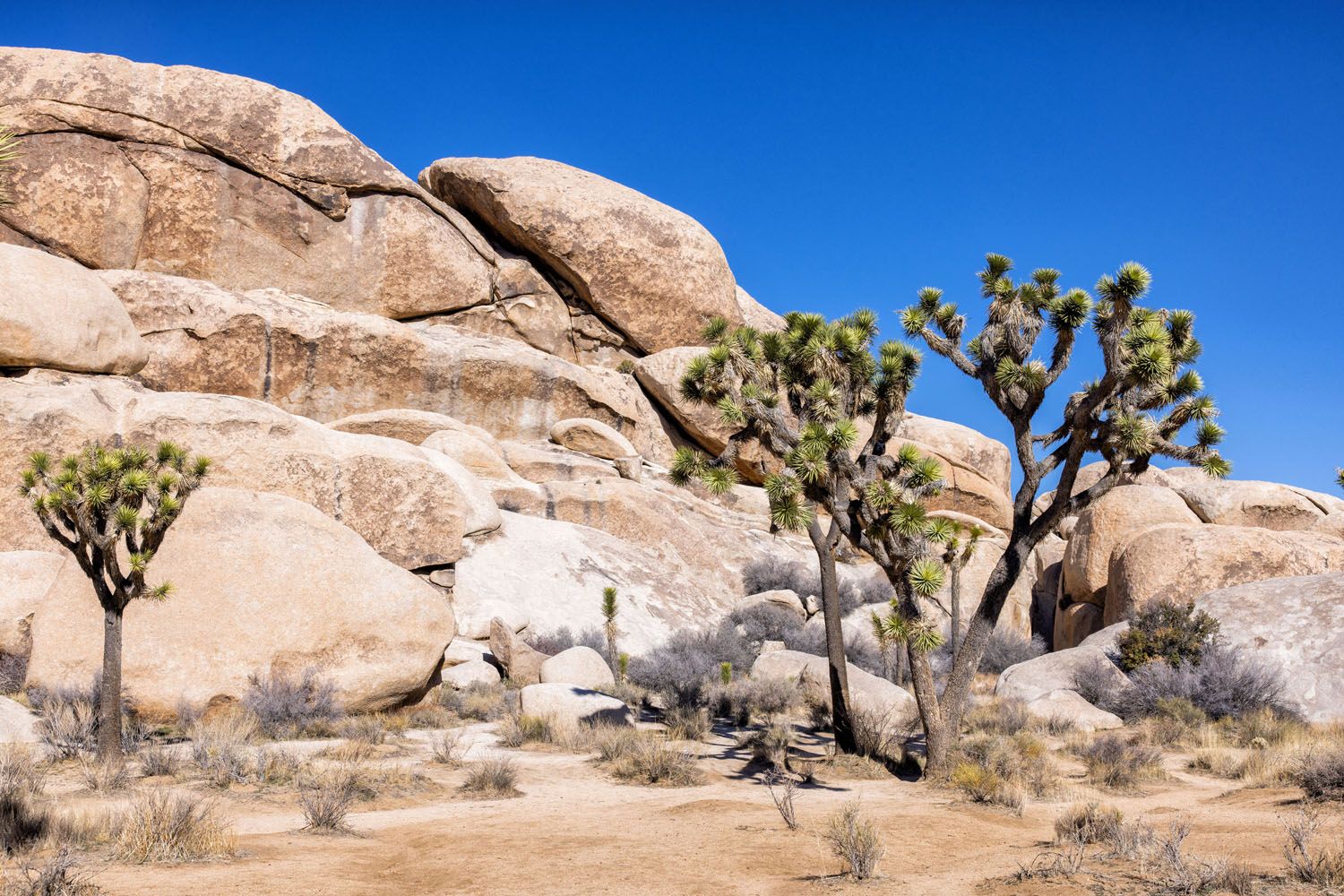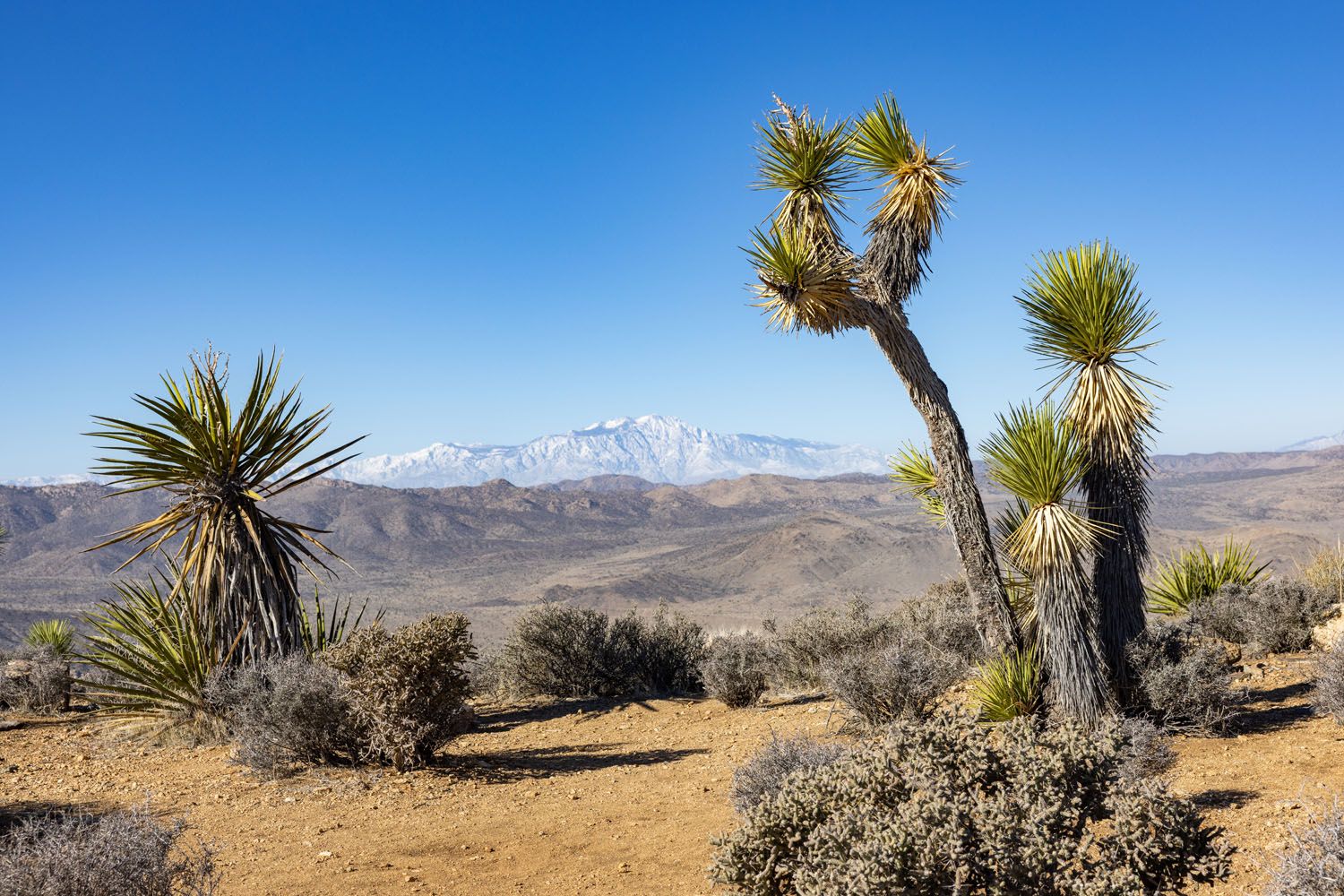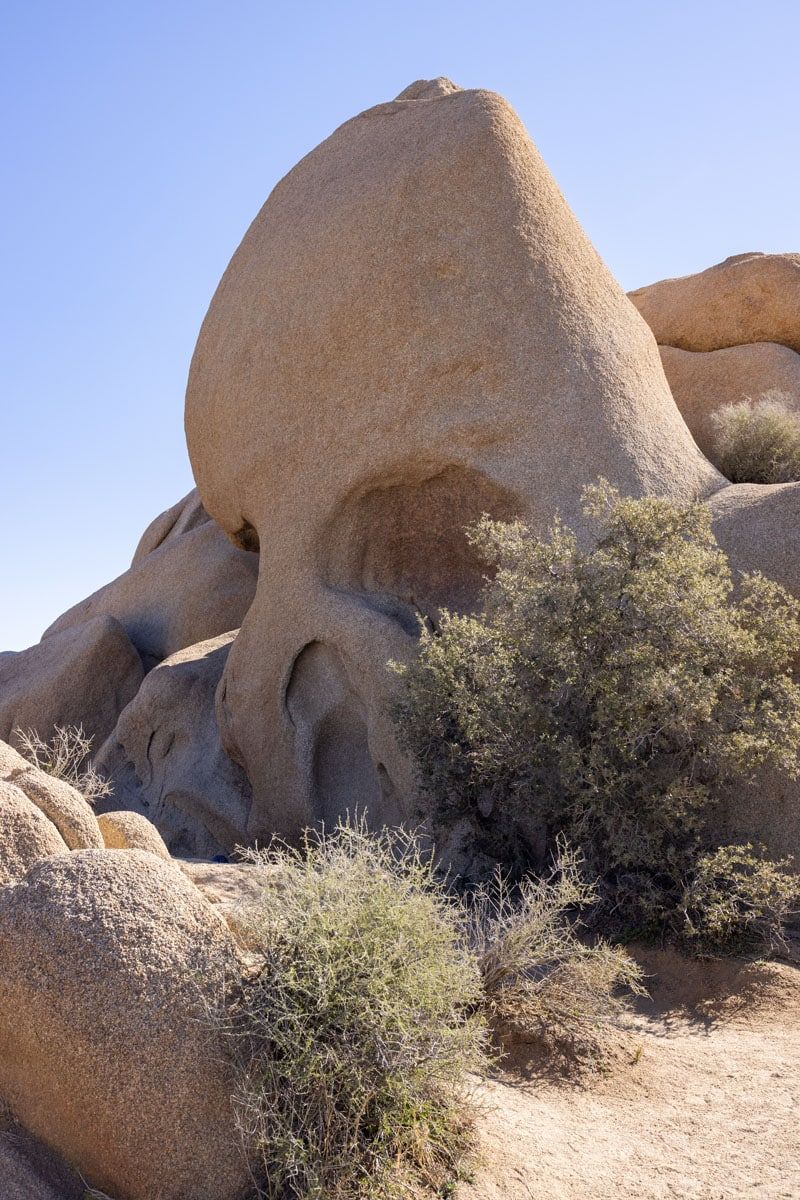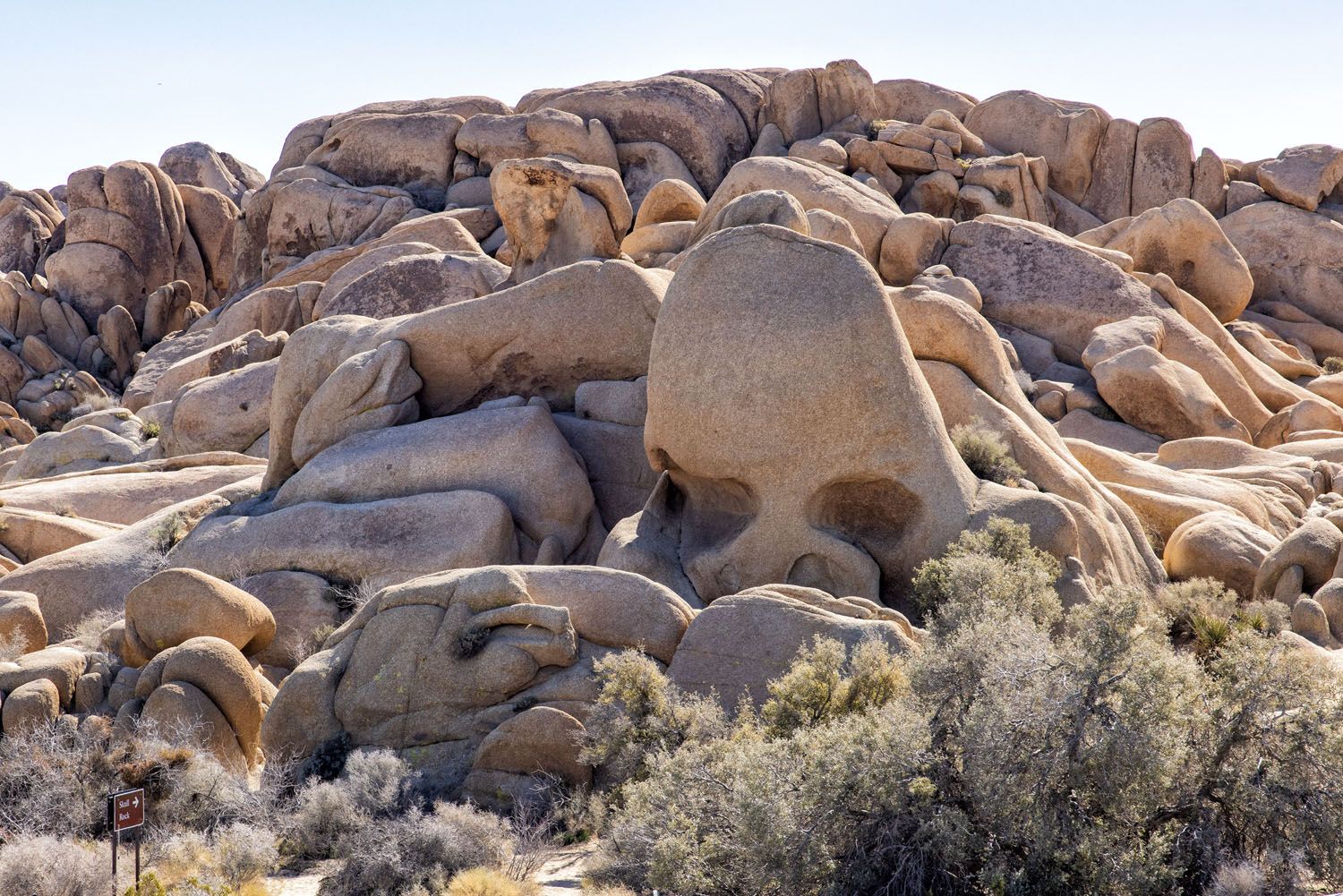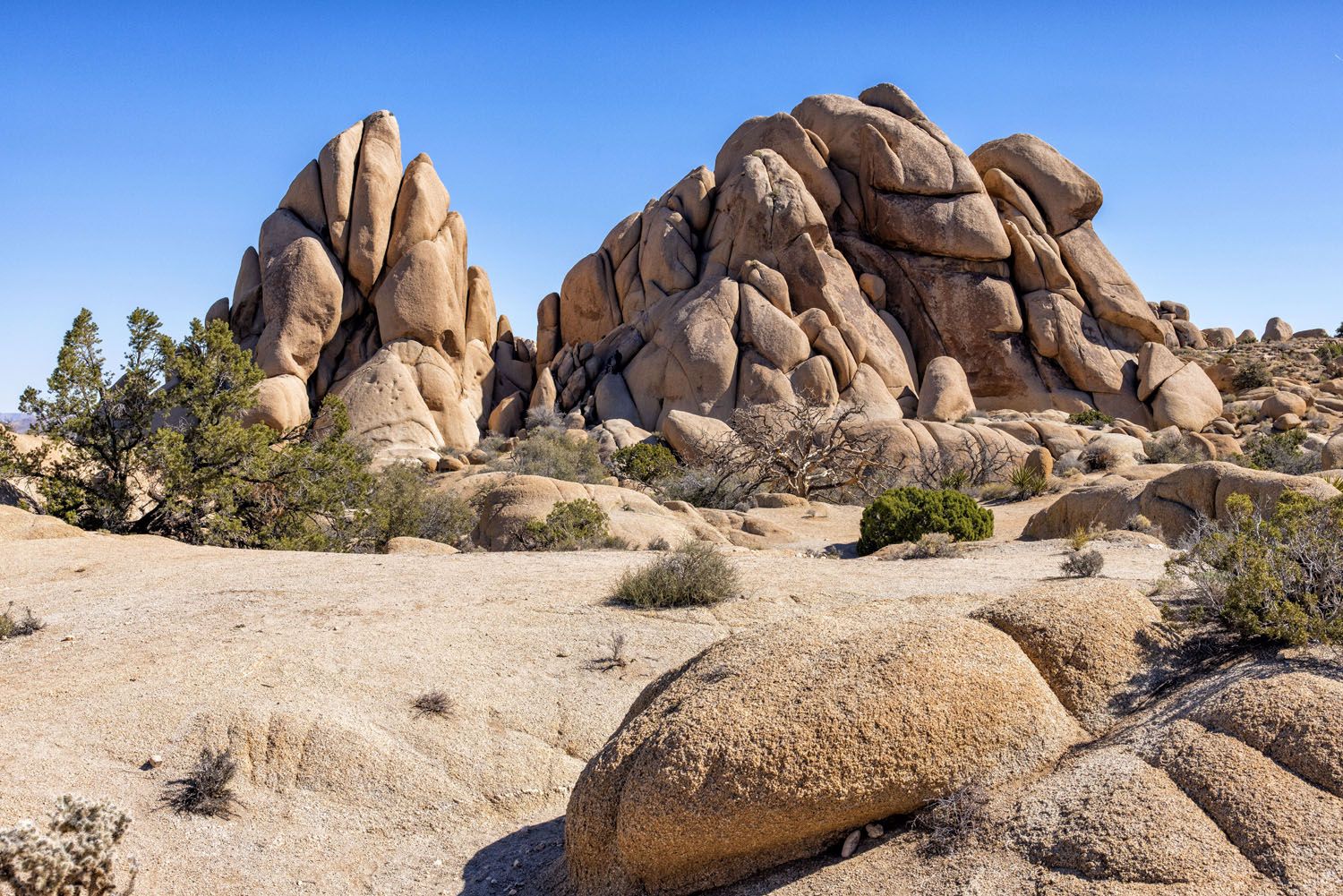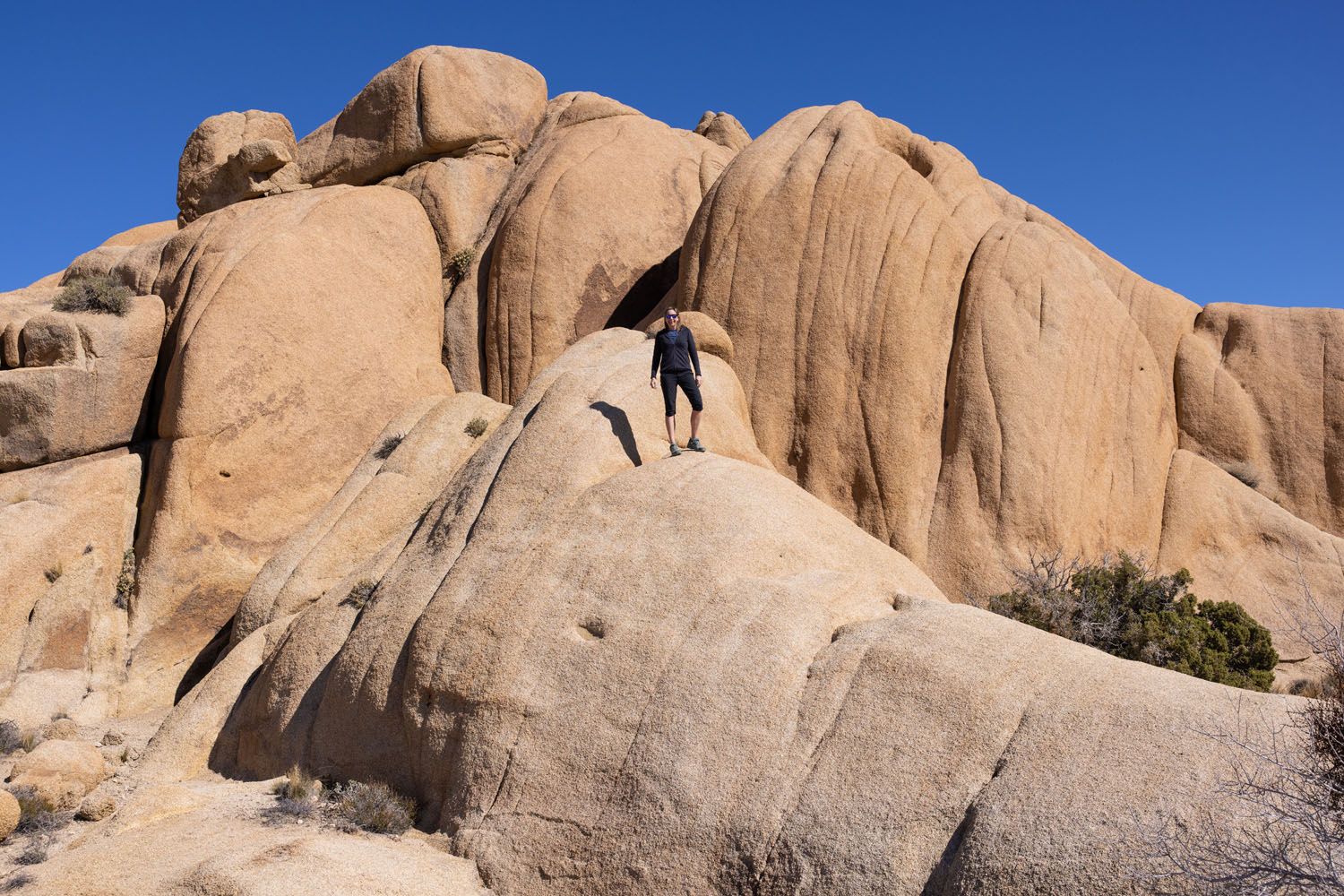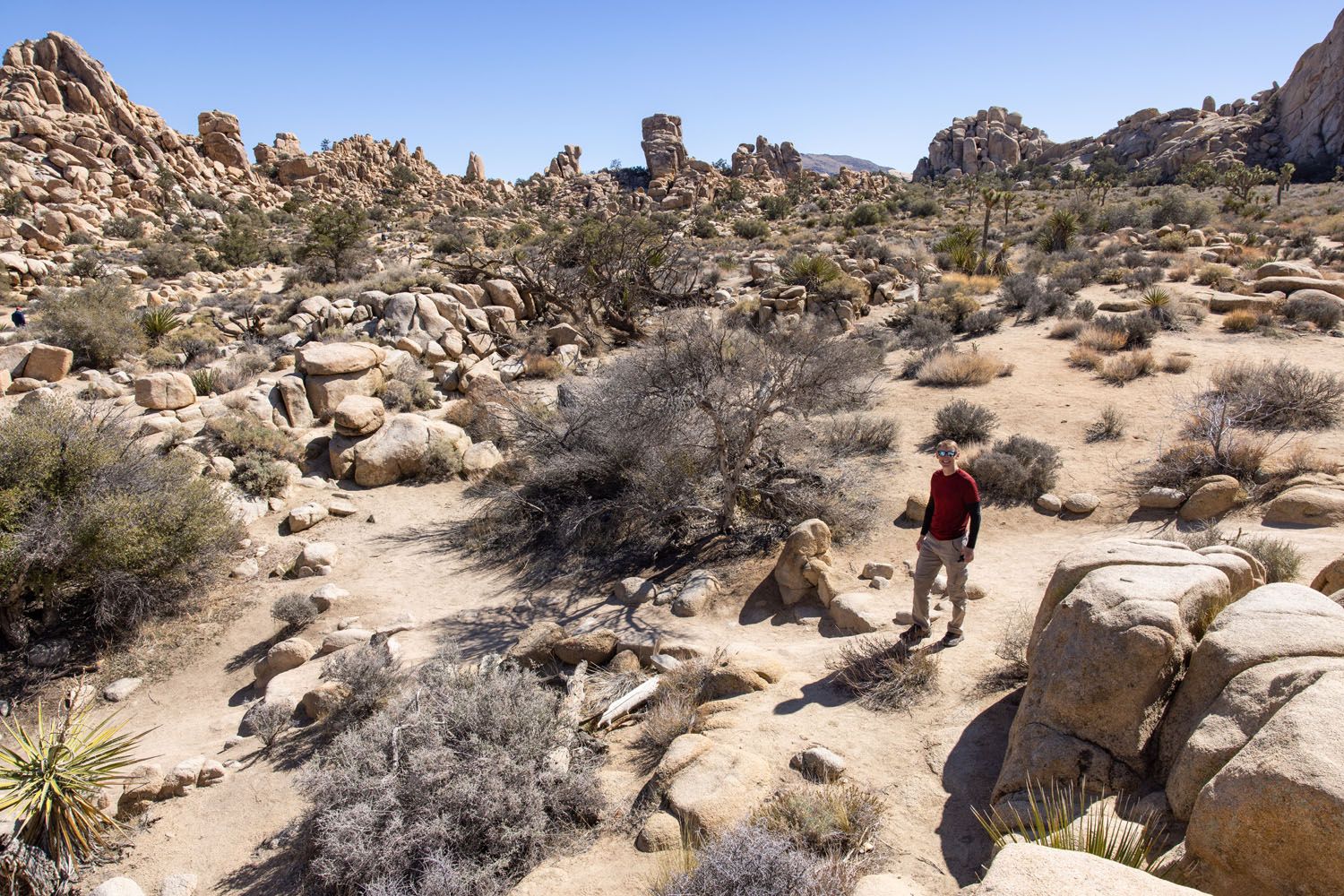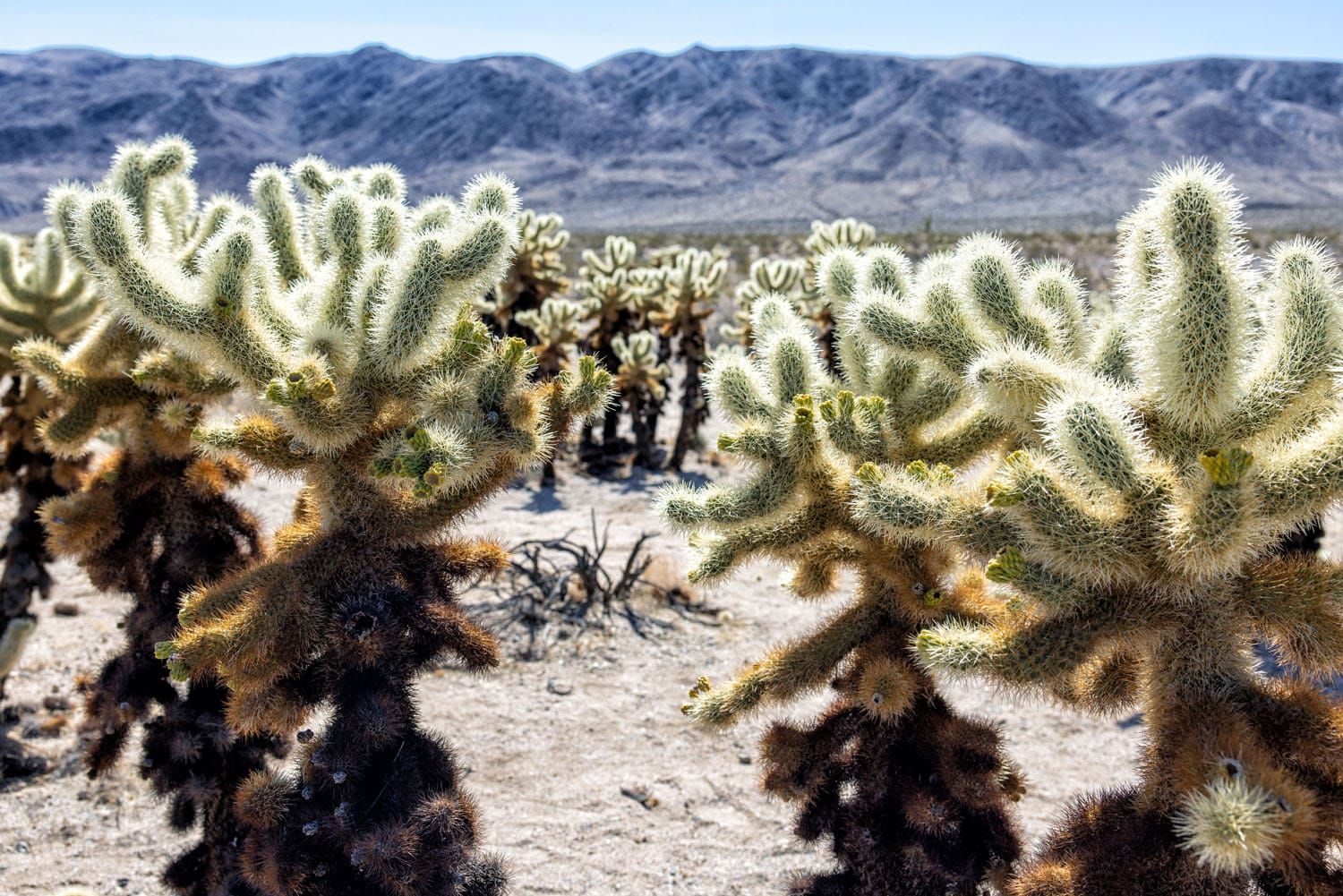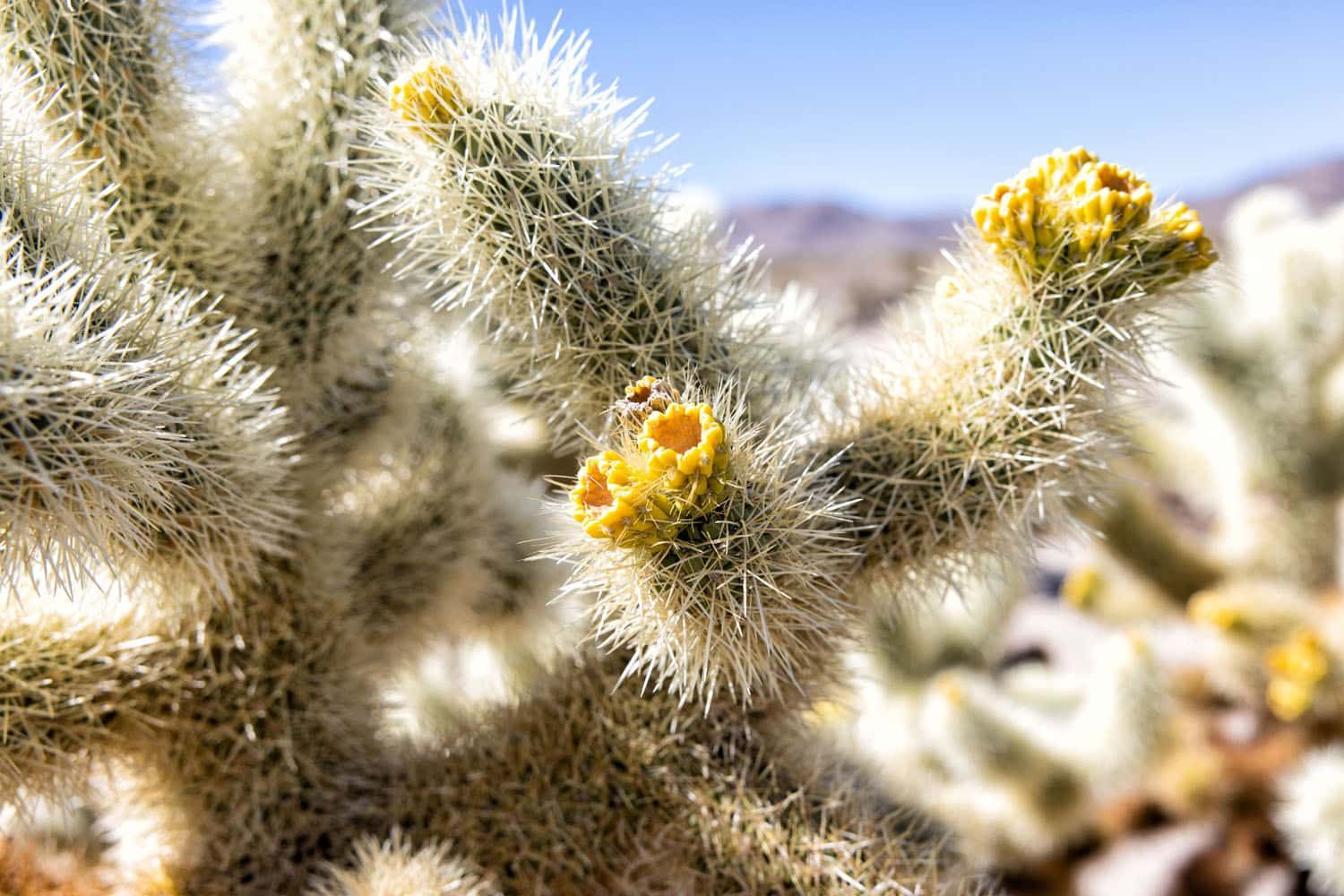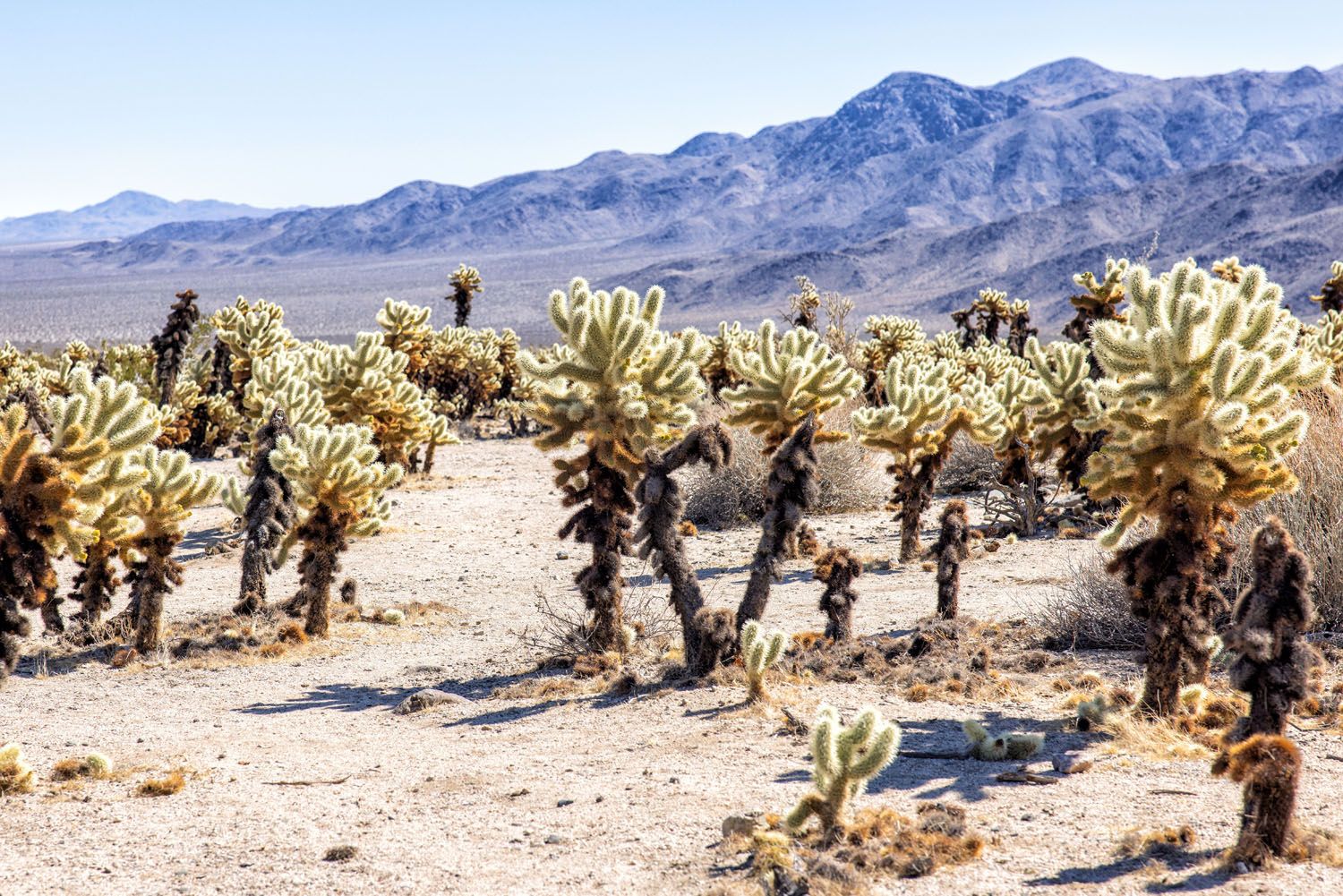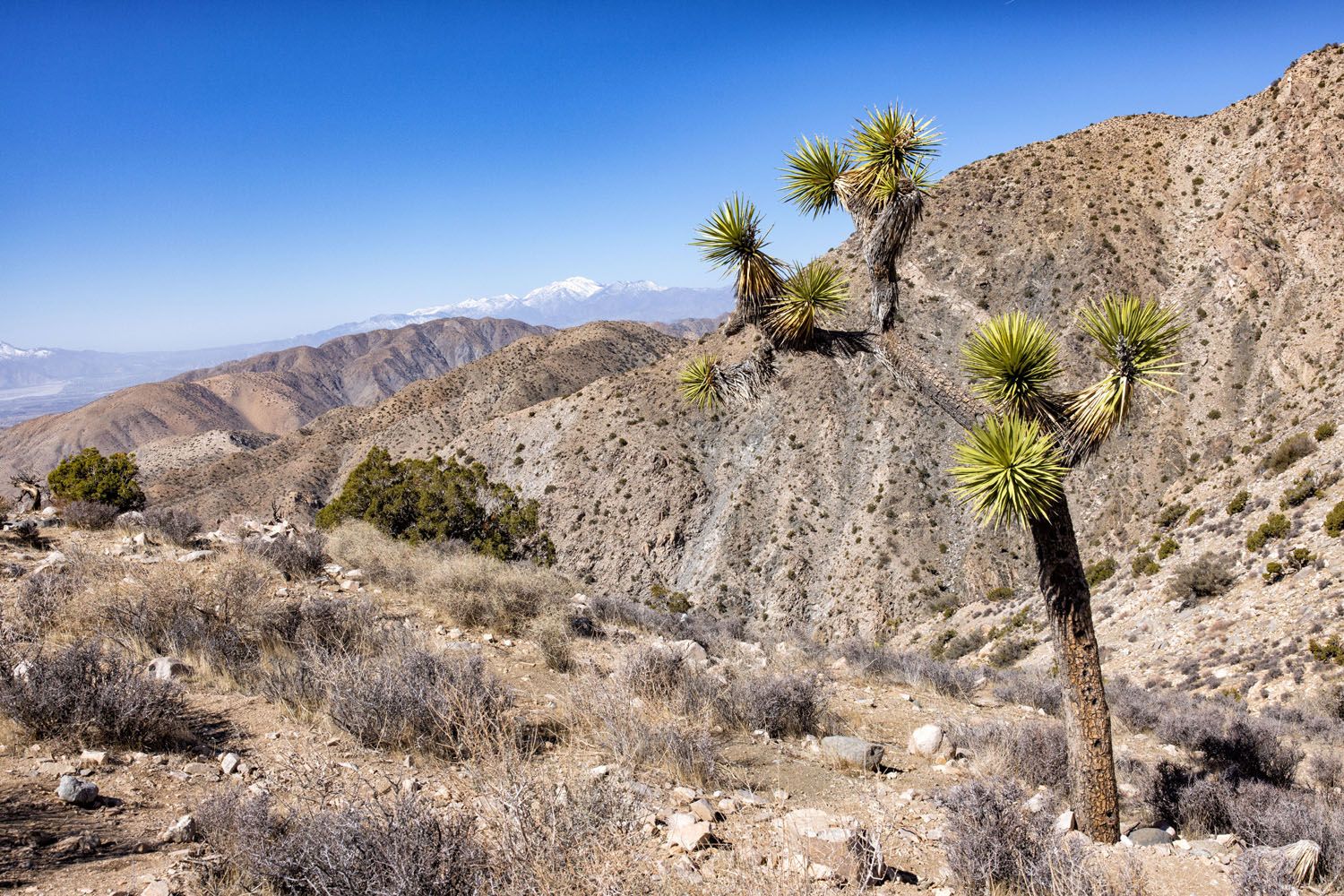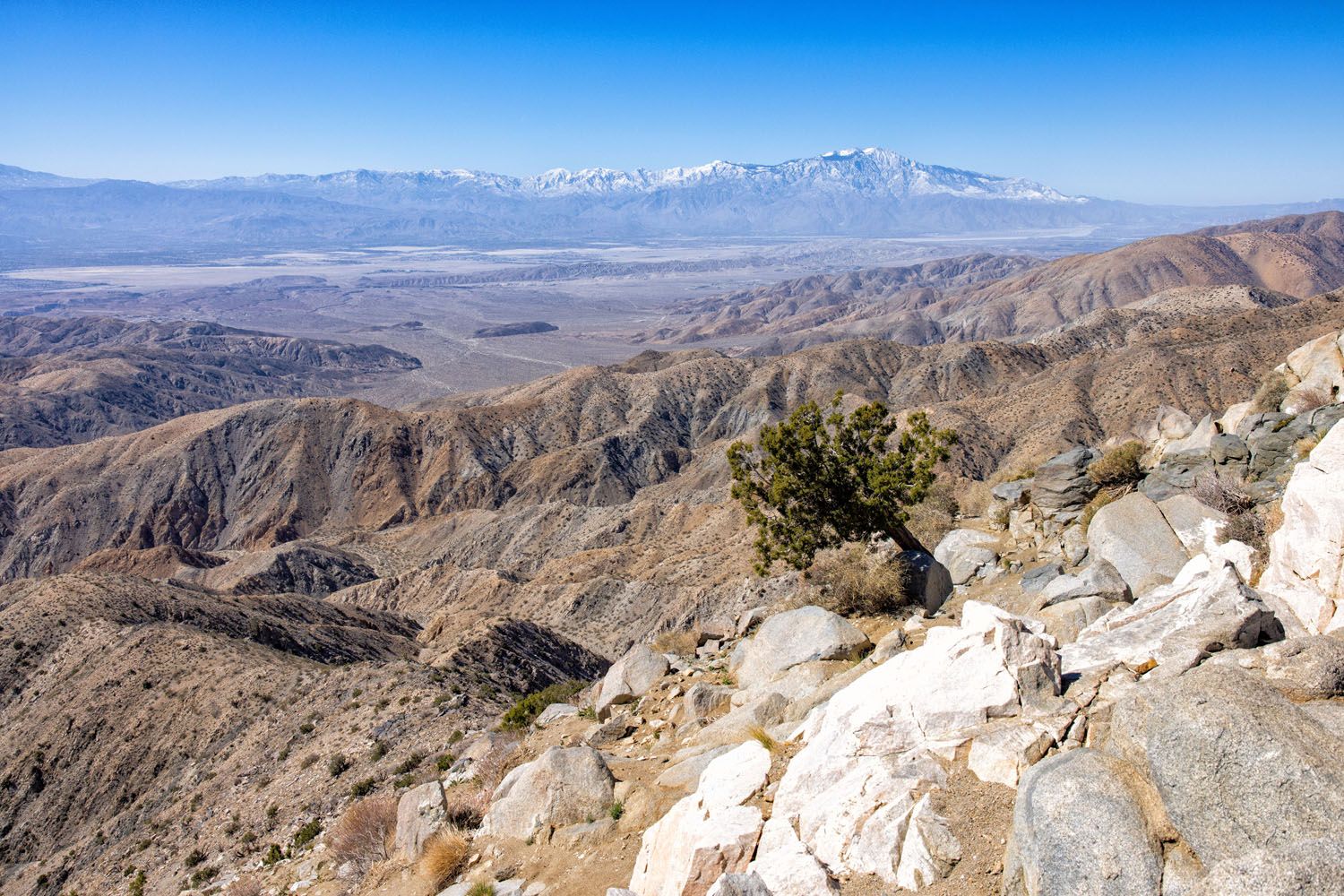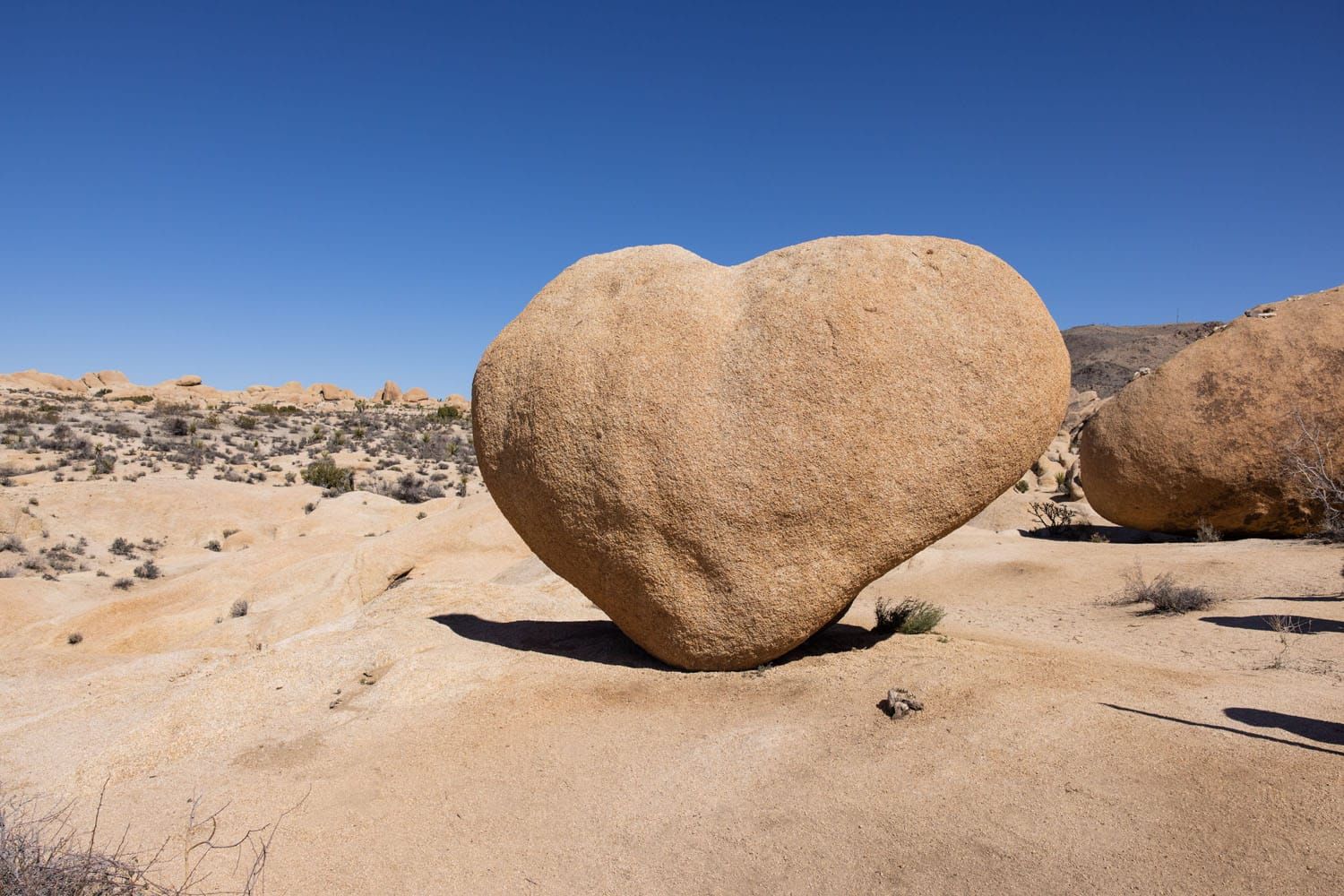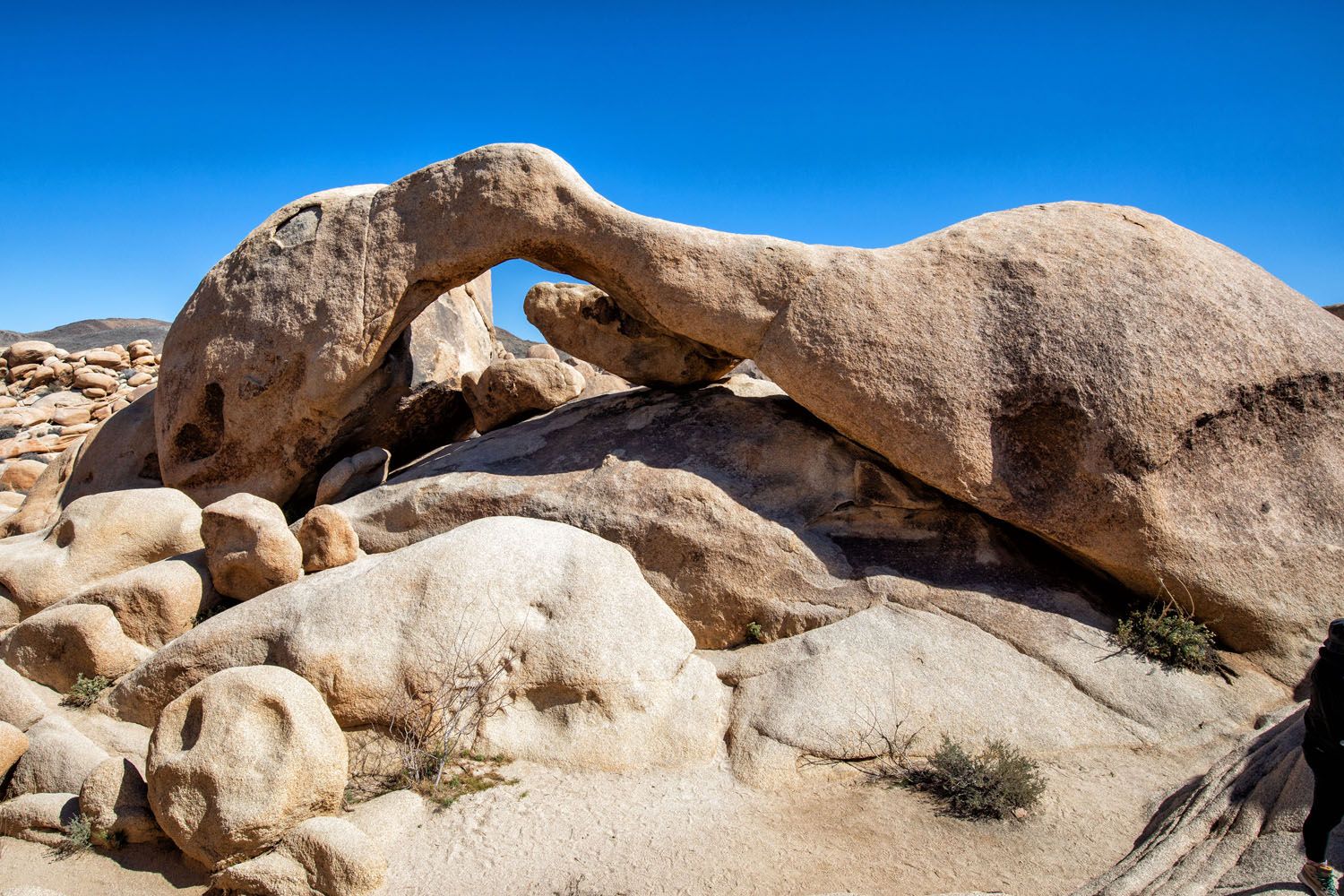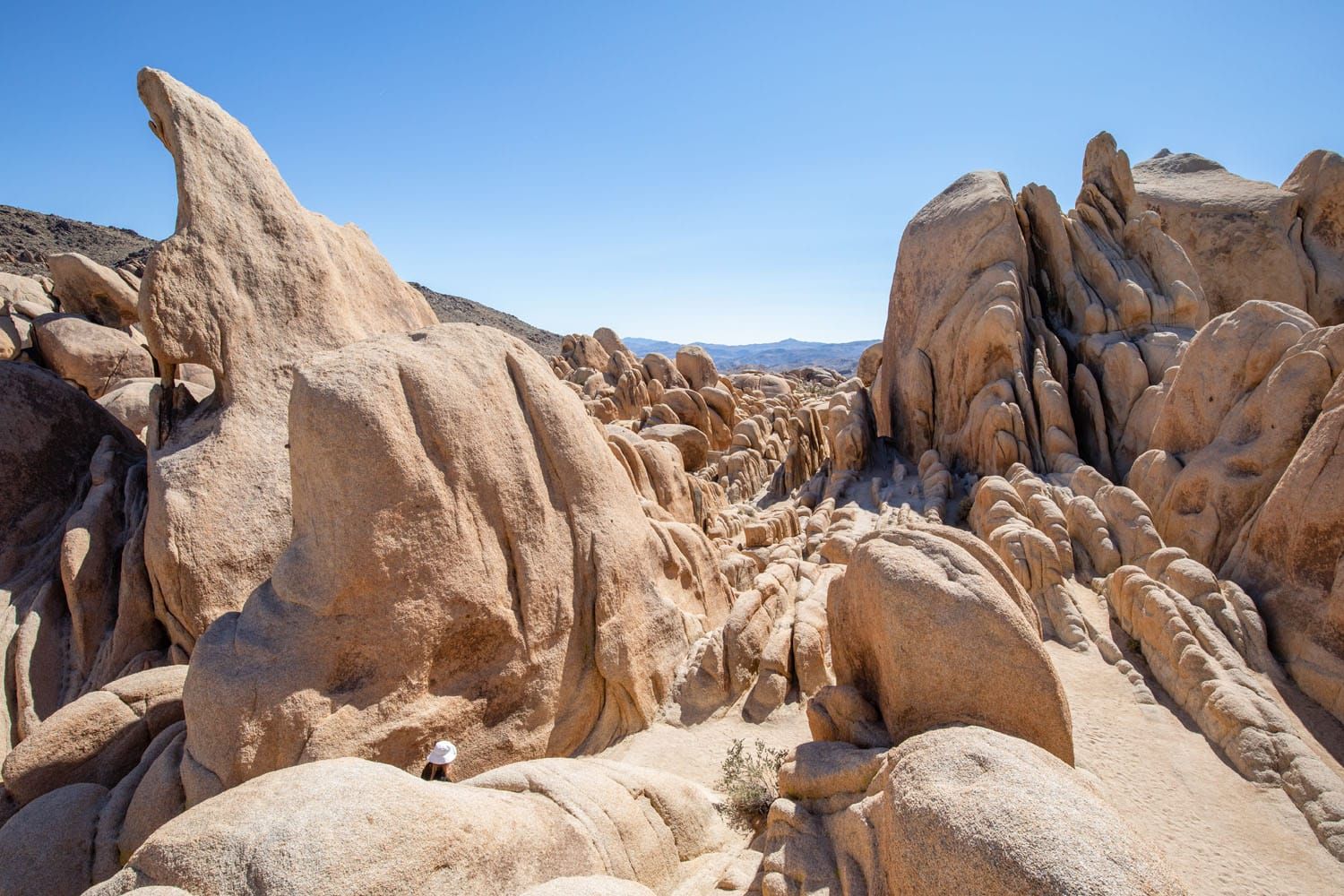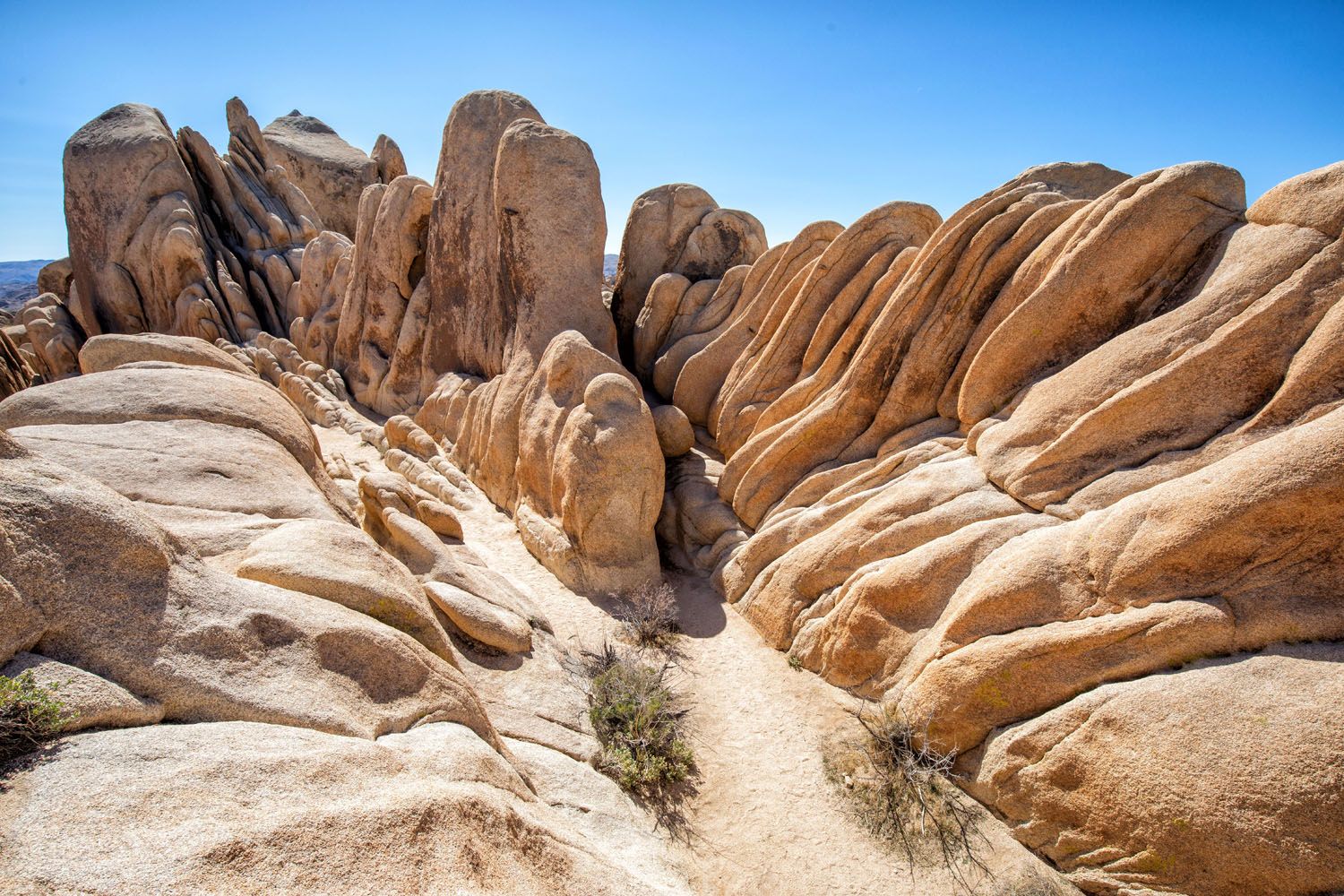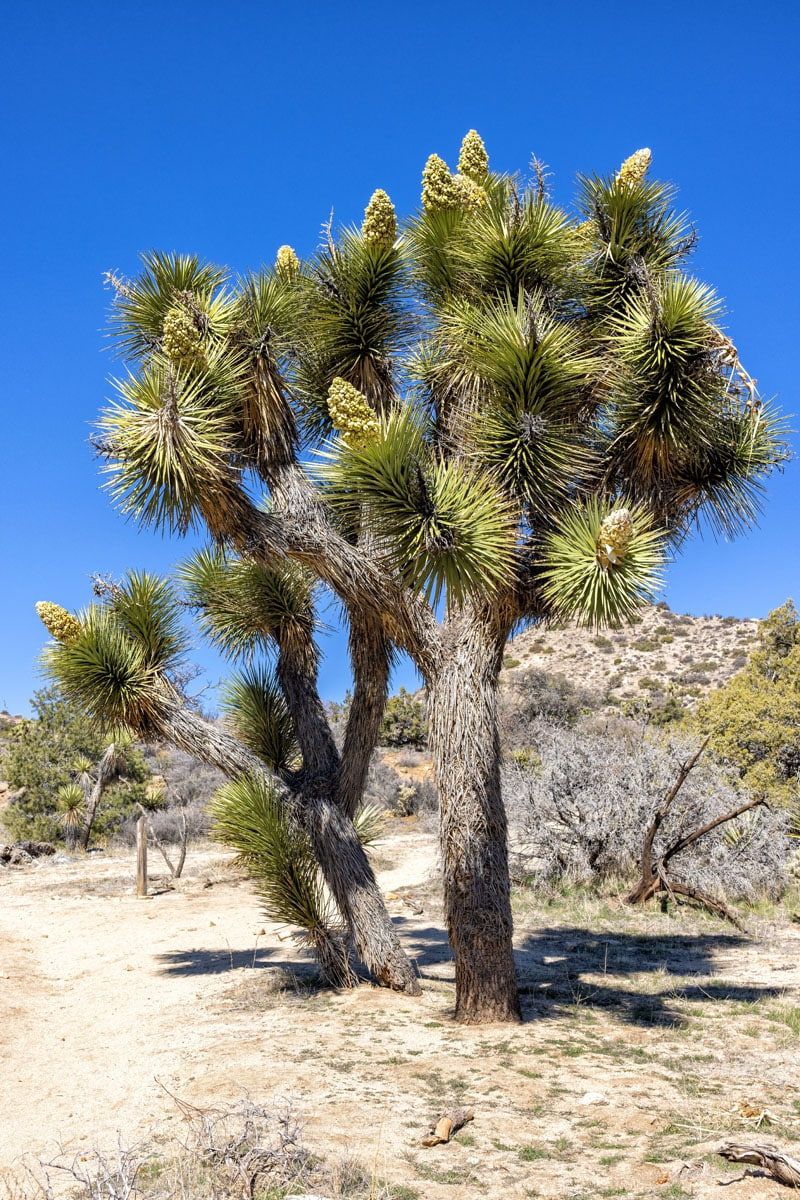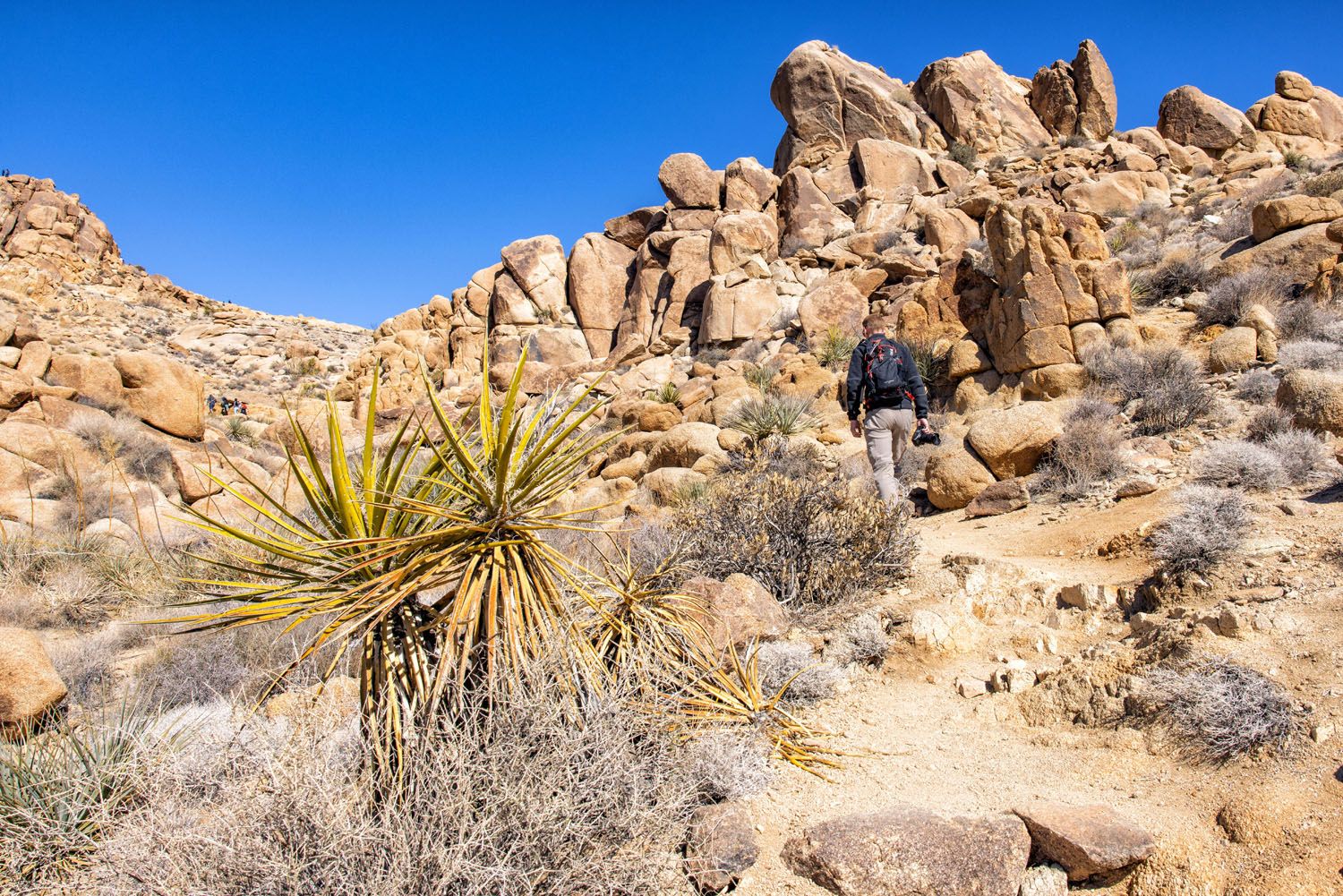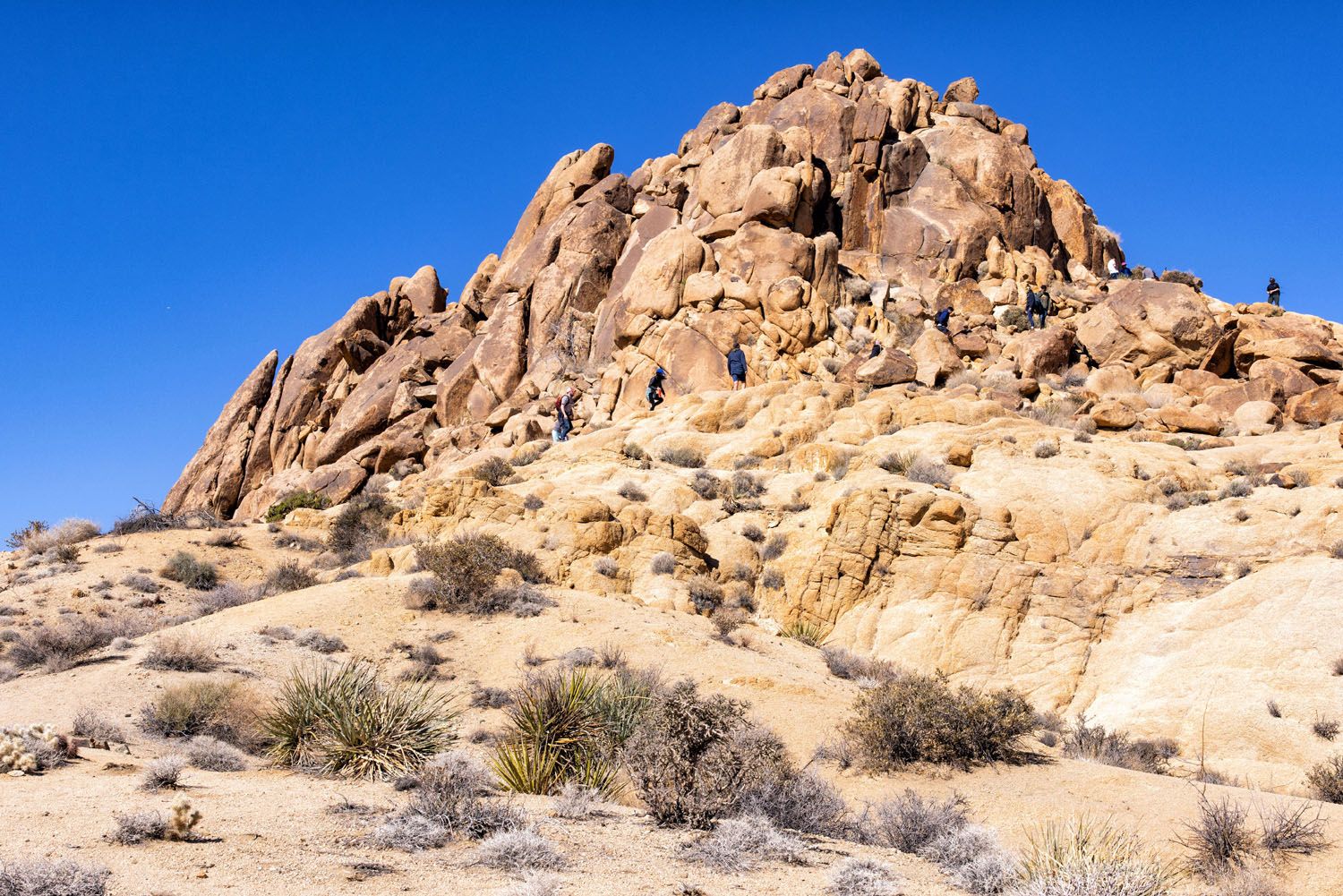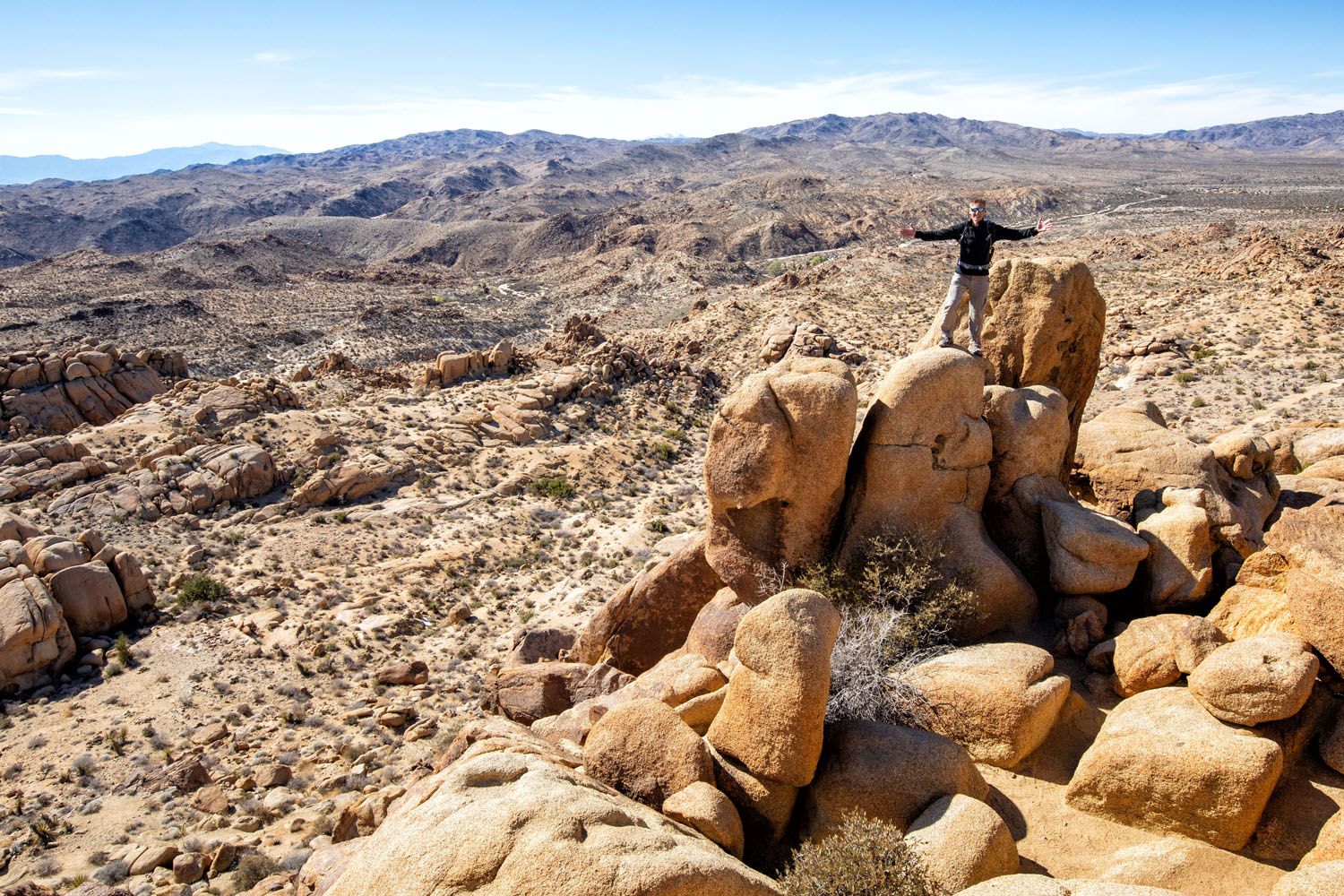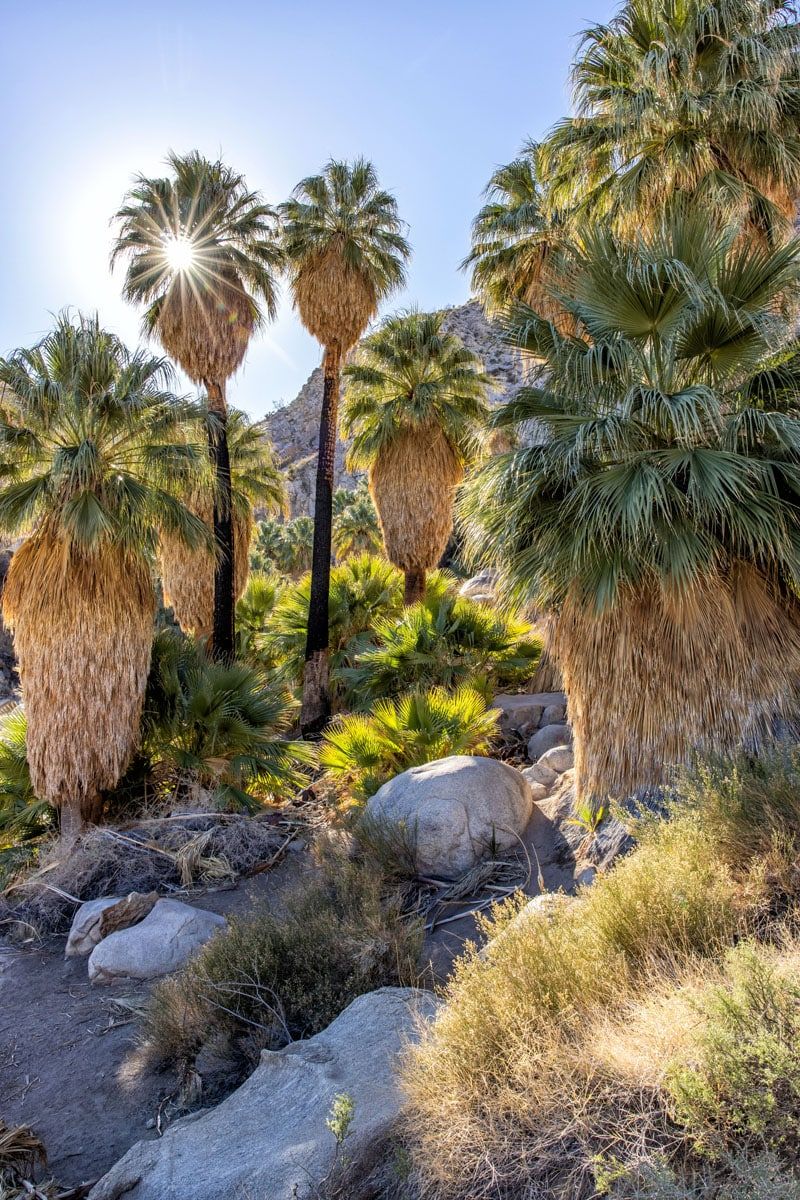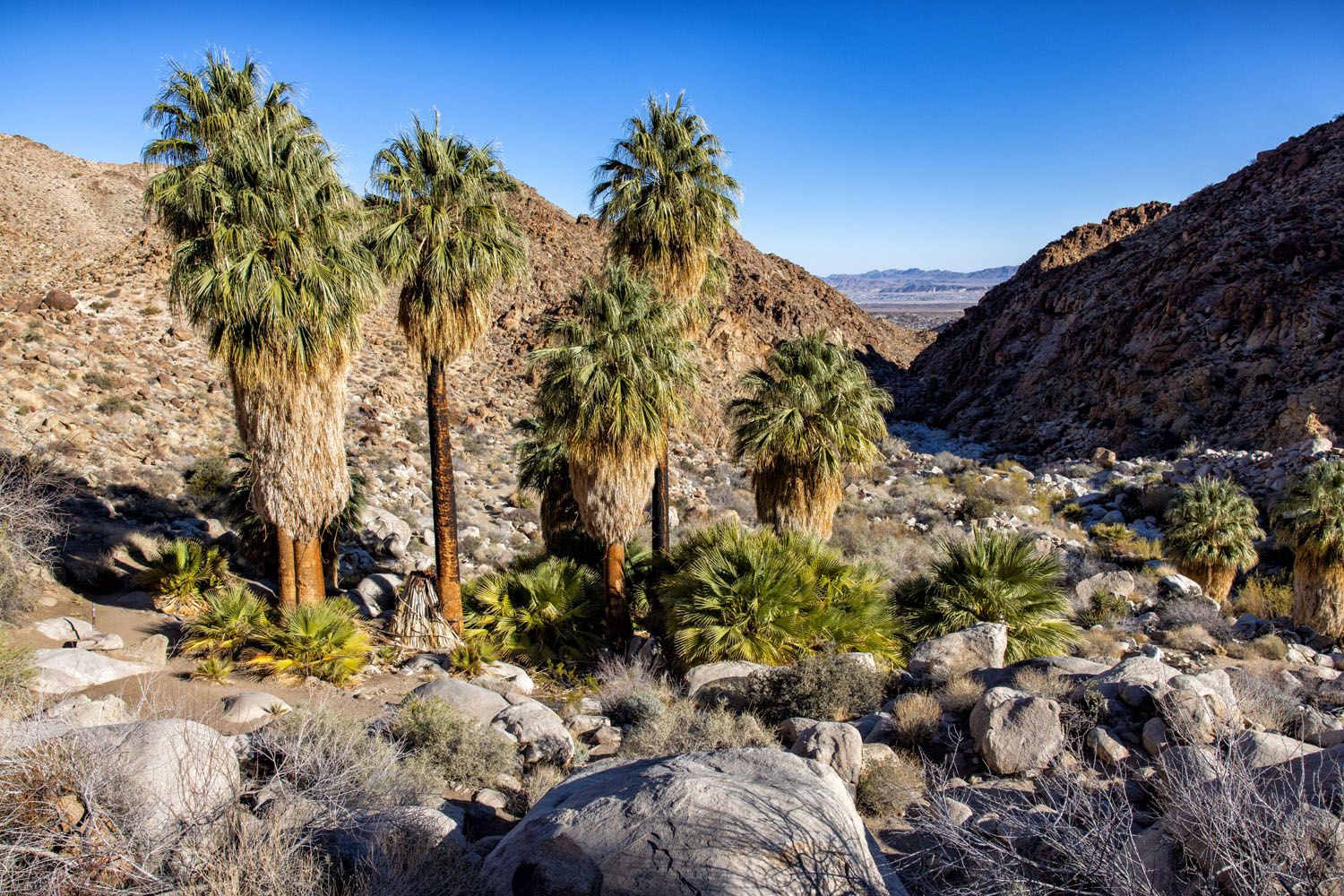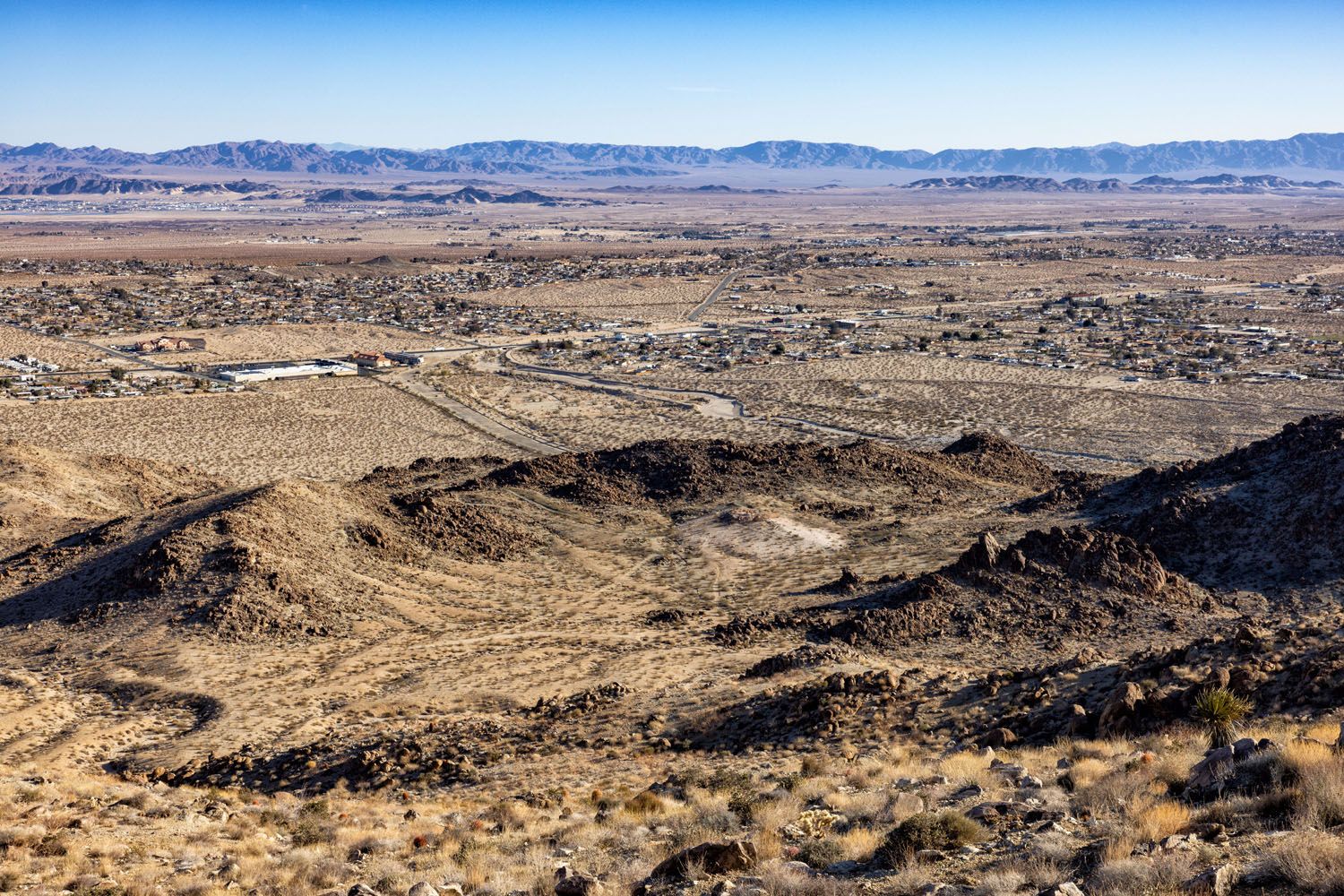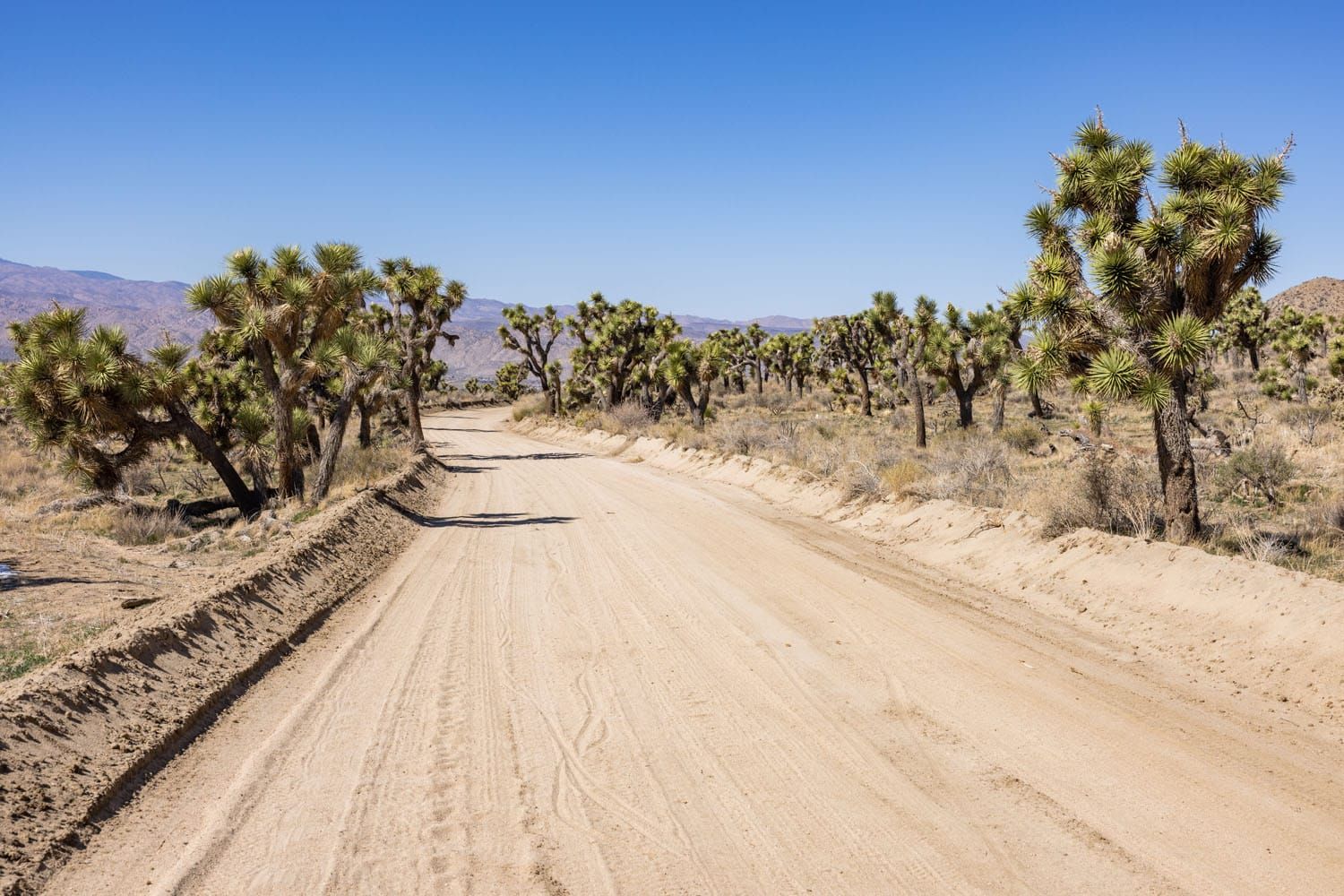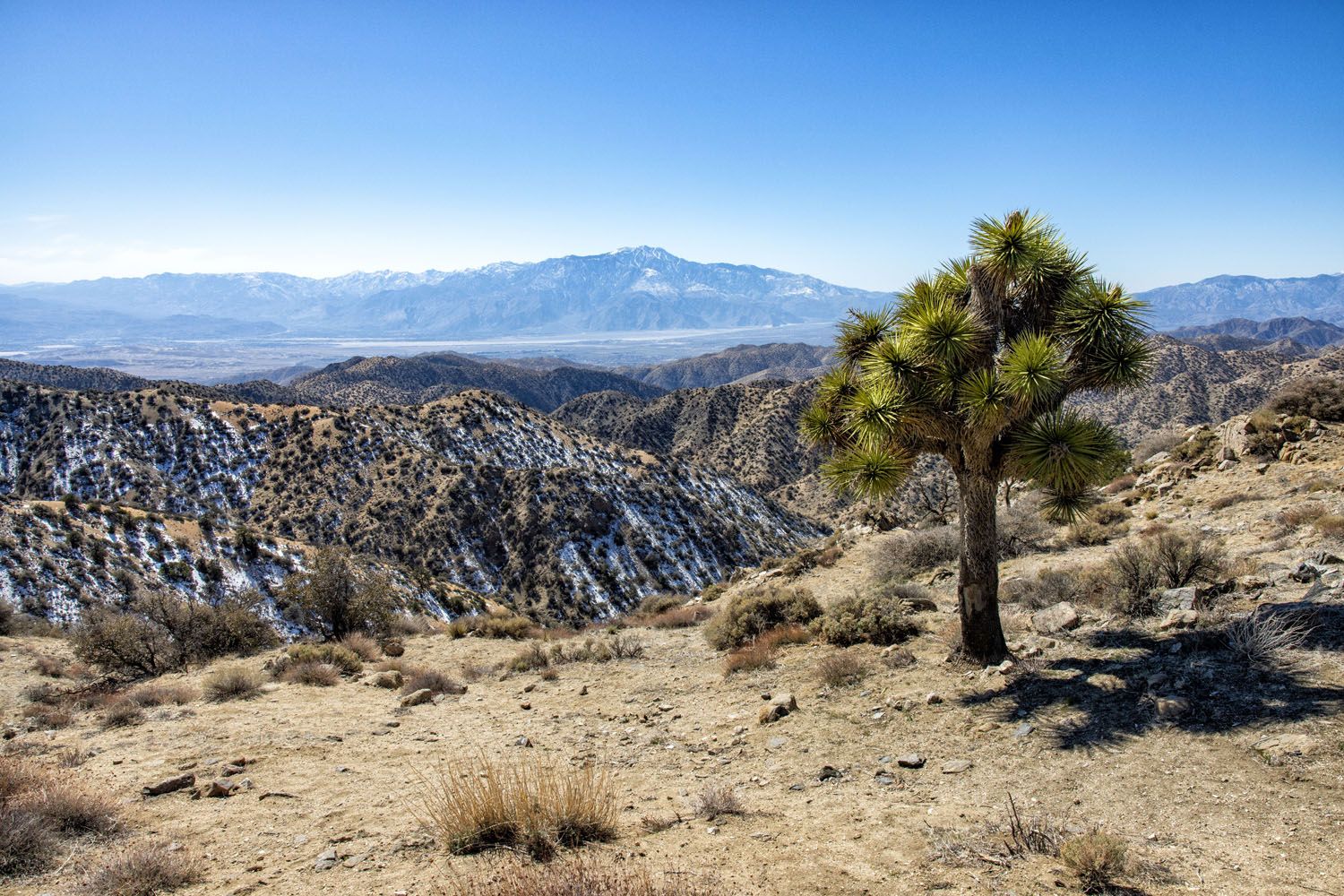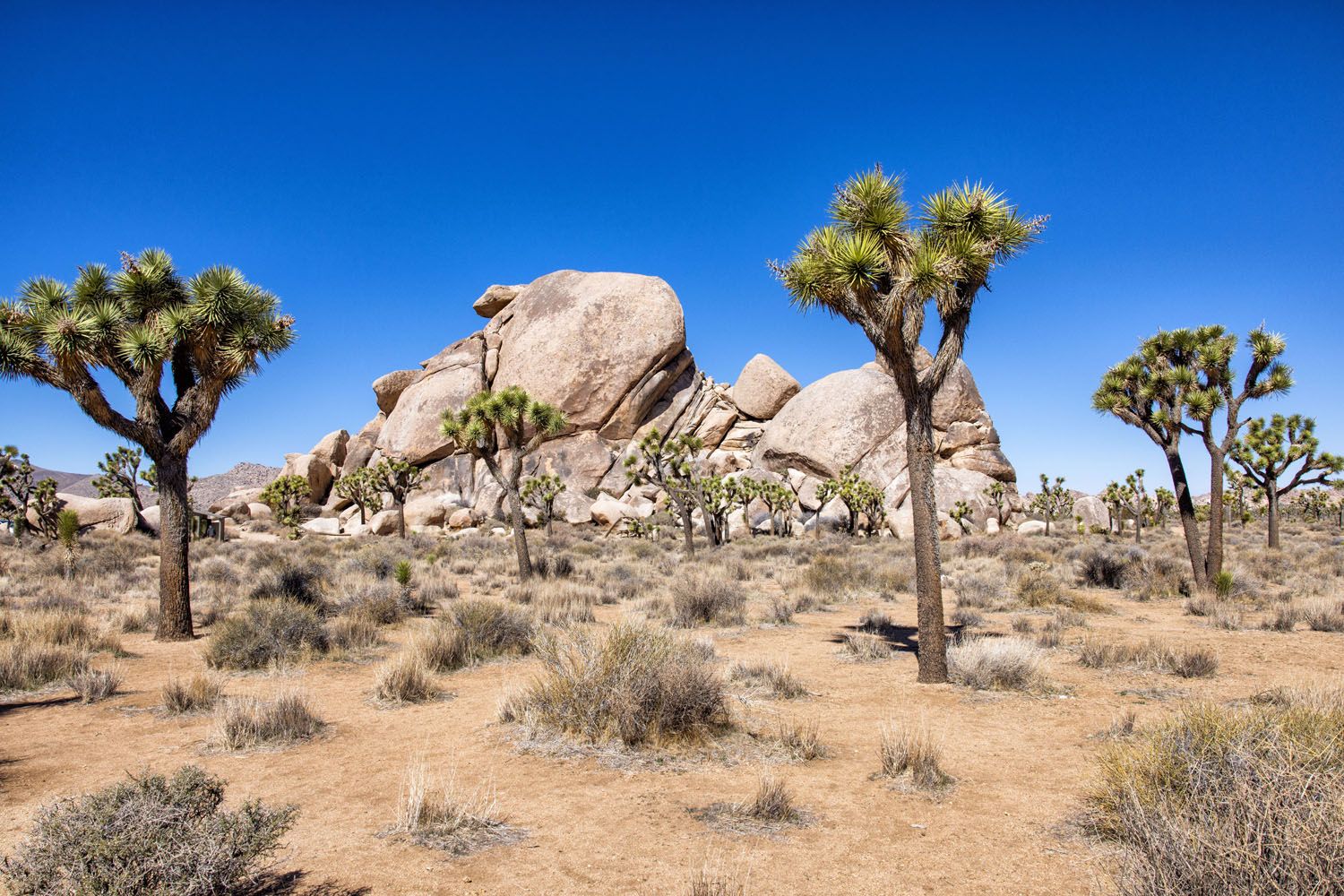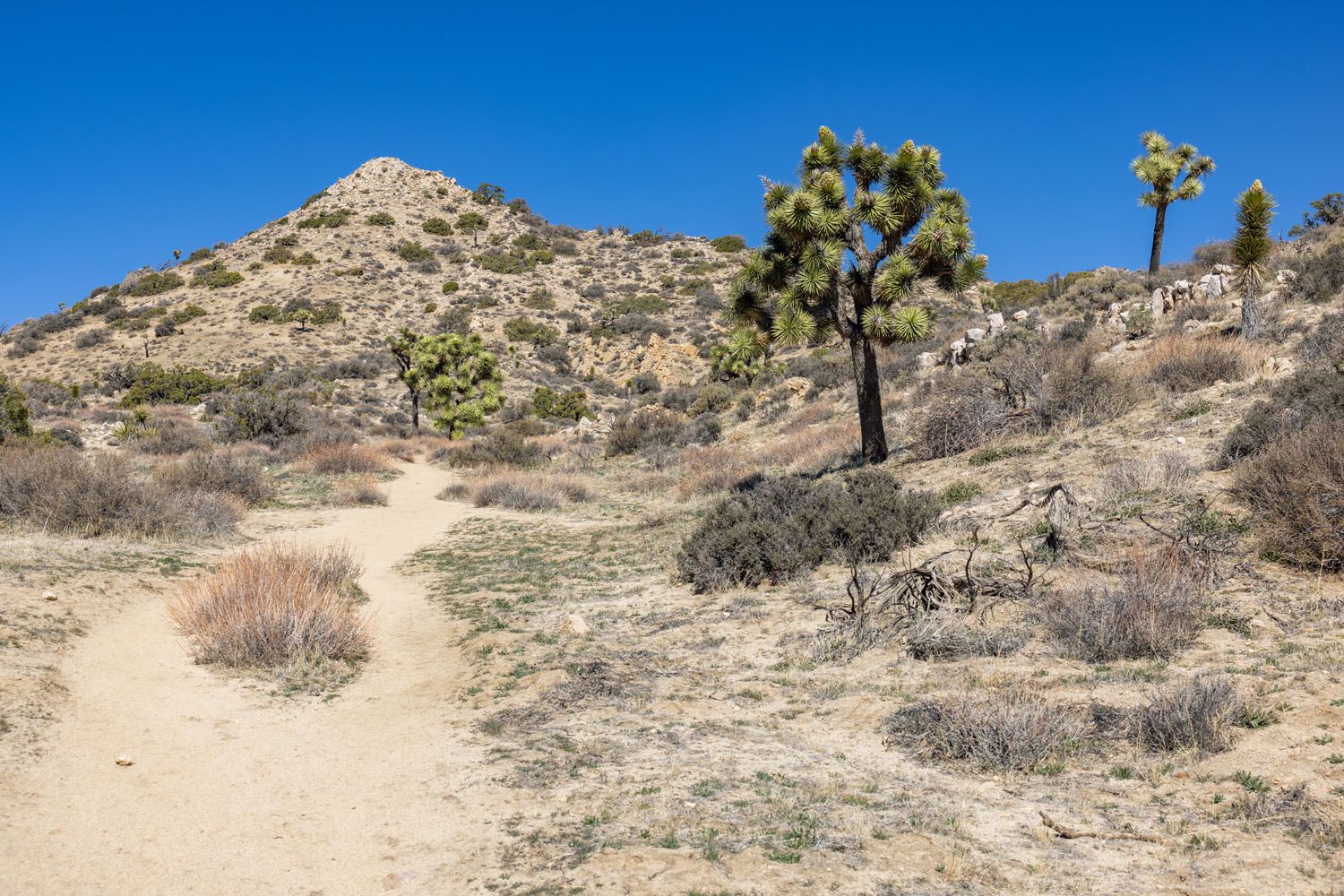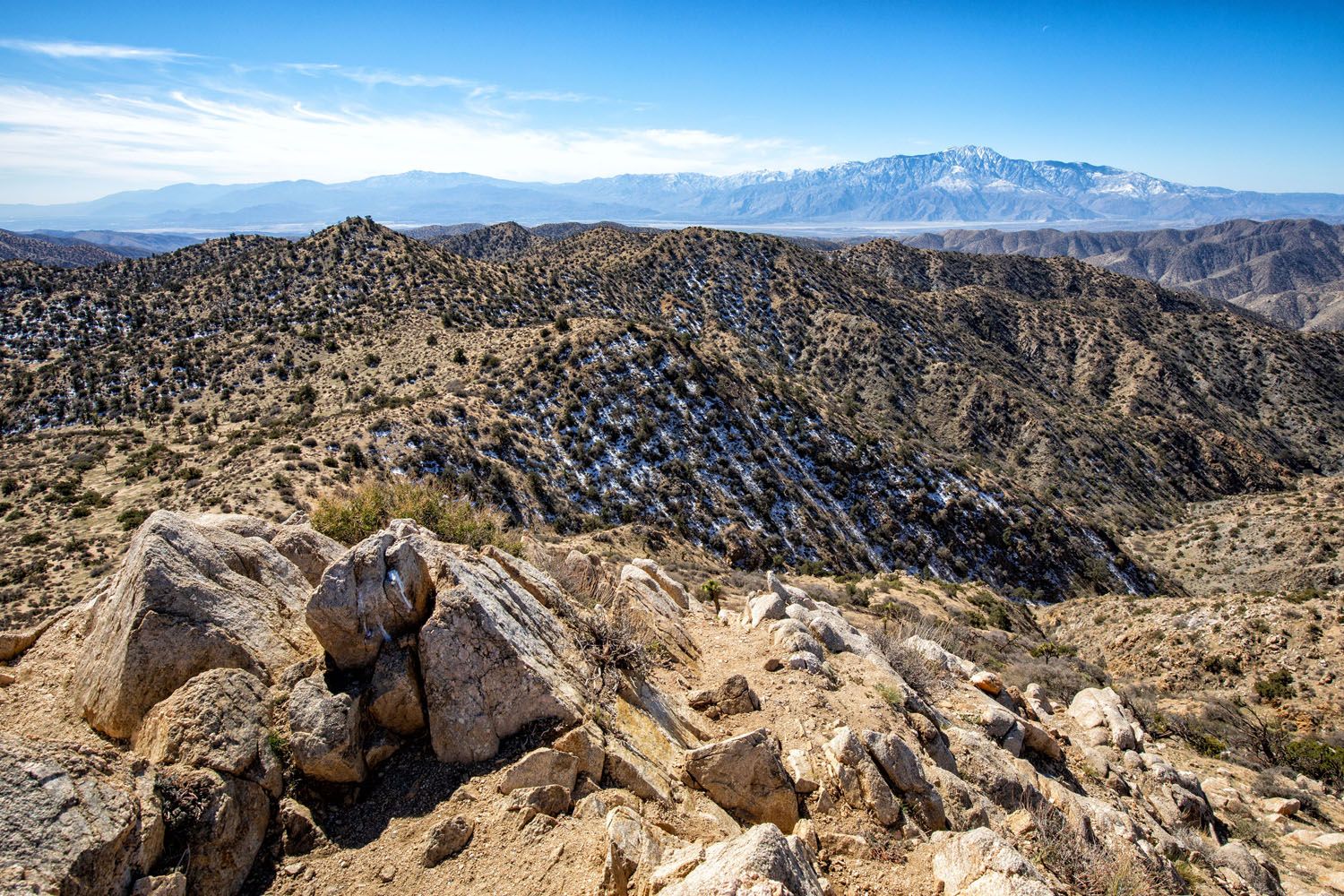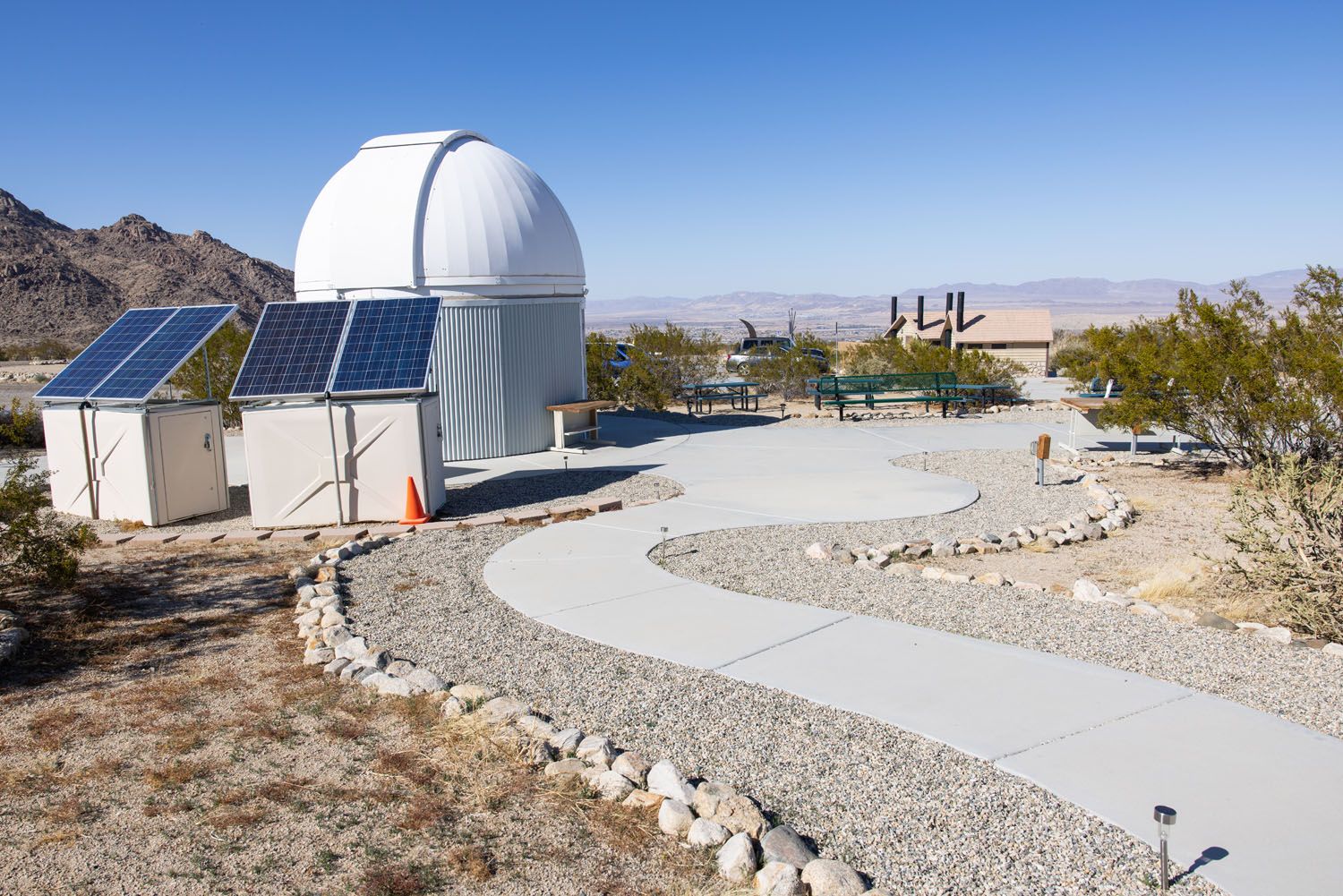Joshua Tree National Park
With its desert scenery, hiking trails, rock climbing routes, hidden oases, scenic drives, and trees that look like they have been plucked from the pages of a Dr. Seuss book, Joshua Tree National Park is a joy to explore.
Joshua Tree National Park gets its name for the Joshua trees, which are found throughout the park and the Mojave Desert. Seeing these trees are one of best things to do on a visit to Joshua Tree, but you can also fill your time by hiking one of the many trails, gazing out across the desert from the tallest peaks, and learning about the other plants and wildlife that thrive in these desert conditions.
Joshua Tree National Park Stats
Founded: October 31, 1994
Annual Visitors: 3.3 million in 2023
Size: 800,000 acres
Location: California
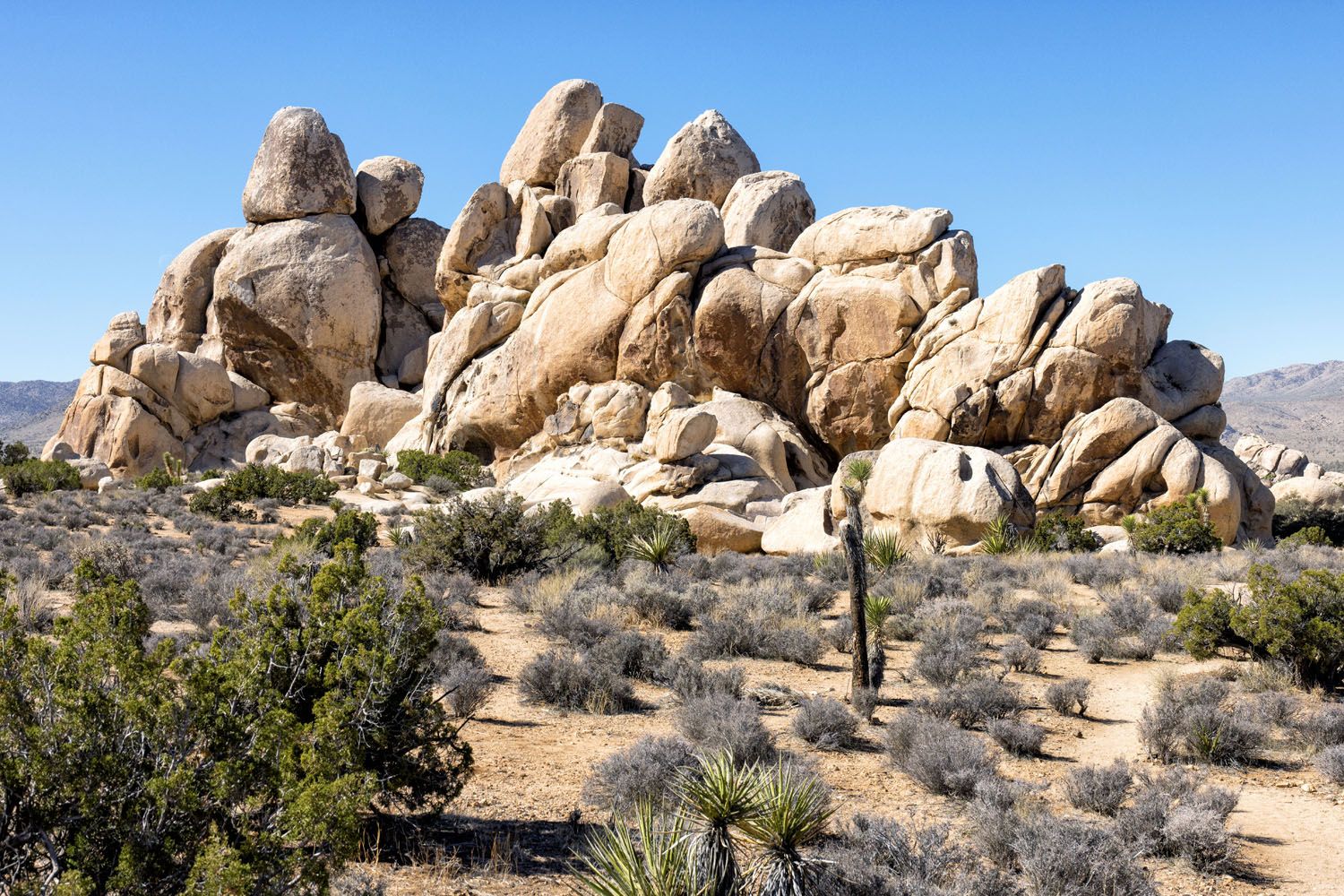
Top Ten Experiences in Joshua Tree
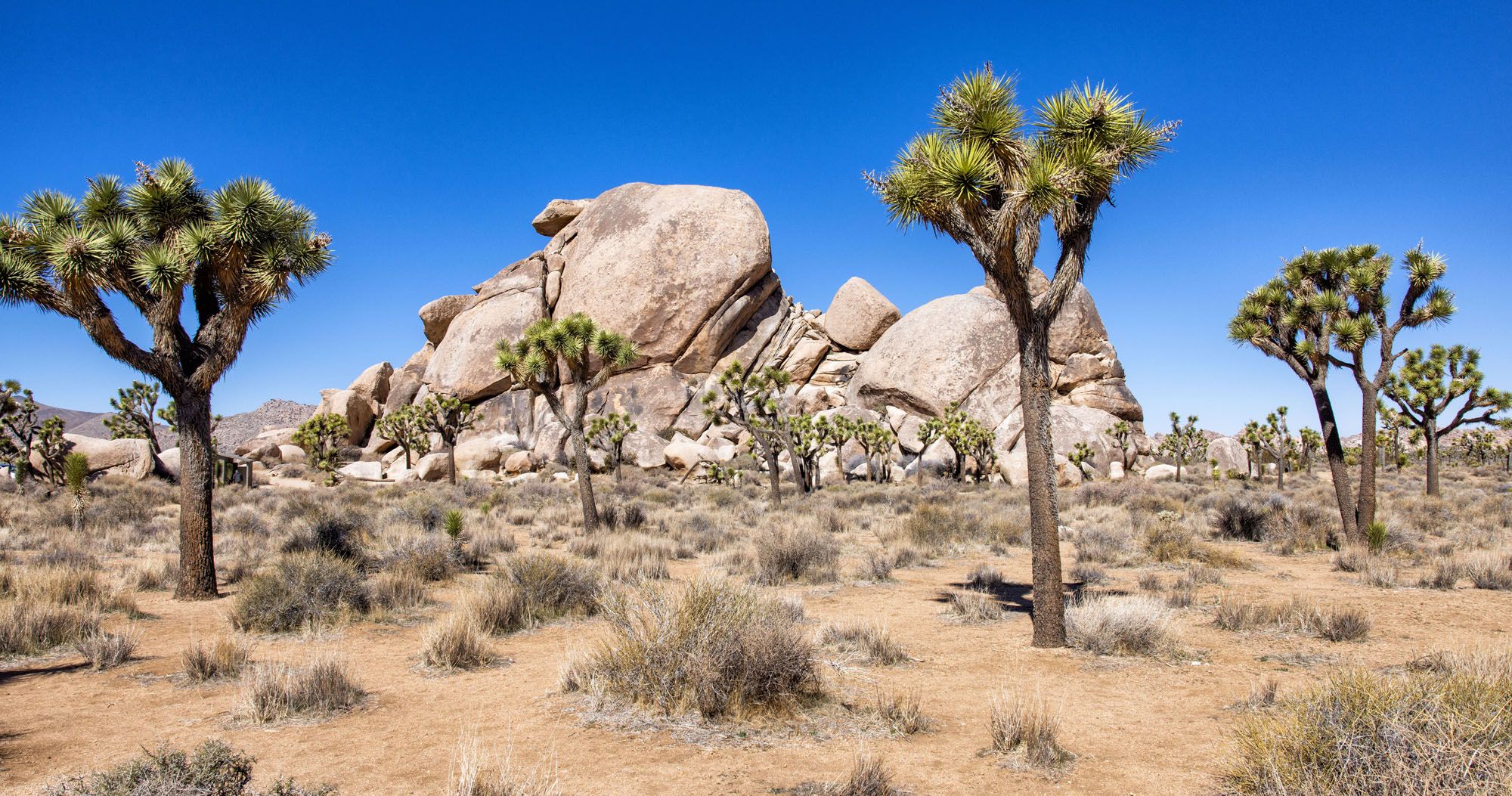
10 Things to Do in Joshua Tree National Park on Your First Visit
In this guide, we cover the best things to do in Joshua Tree National Park with tips to have the best experience.
Go Hiking. Hiking one of the many trails is one of the best things to do in Joshua Tree National Park. Hikes range from short, easy nature trails to more challenging hikes that summit the highest peaks or include sections of rock scrambling.
Go rock climbing. Joshua Tree National Park is a world-renowned rock climbing destination. There are more than 8,000 rock climbing routes in this park.
Explore Hidden Valley. Hidden Valley is one of the most picturesque areas of Joshua Tree National Park. Hike through a valley that is surrounded by rocky walls and desert plant life. It’s a short, beautiful walk.
Cholla Cactus Garden. The Cholla Cactus Garden is one of the most unique sights in Joshua Tree National Park. This large cluster of cactus is fun to visit and fun to photograph.
Keys View. Keys View is one of the best viewpoints in Joshua Tree National Park. From this overlook, you have a panoramic view of the Santa Rosa Mountains, San Jacinto Mountain, Coachella Valley, and Palm Springs. The San Andreas Fault, which runs from San Francisco to the Gulf of California, runs through the valley below.
See Skull Rock. Skull Rock is one of the most photographed rocks in the park. This rock, at the right angle, resembles a skull. It is located on Park Boulevard and can be seen right from the road.
Drive Geology Tour Road. Geology Tour Road is the most popular 4WD road in Joshua Tree National Park. It is well maintained by the National Park Service, and as you drive this loop, learn about the geology of the park and how the landscapes were formed.
Drive to Eureka Peak. Eureka Peak is located on the far western end of Joshua Tree National Park. To get here, you need a 4WD vehicle. For most of the drive, you will see hundreds of Joshua trees and, in our experience, not another person. Once you make it to Eureka Peak, enjoy the panoramic views of the San Bernardino Mountains and the Santa Rosa Mountains.
Berdoo Canyon Road. This rugged, rough, unpaved road heads through Berdoo Canyon, cutting through the San Bernardino Mountains. It is about 15 miles long and to drive this road, you must have a high-clearance 4WD vehicle and experience driving on 4WD roads. It is the most adventurous way to enter Joshua Tree National Park.
Go Stargazing. Joshua Tree National Park is an International Dark Sky Park. This is one of the best national parks to view the night sky and photograph the Milky Way.
Did You Know?
Two ecosystems meet in Joshua Tree National Park: the Mojave Desert and the Colorado Desert.
Of these two deserts, the Mojave is higher and cooler. At about 4,000 feet, it can be quite chilly here in the winter months. It is in this desert, and this part of the national park, that you will find giant piles of smooth boulders and Joshua trees.
The lower Colorado desert makes up the eastern side of Joshua Tree National Park. The landscape looks vastly different here, with cholla cactus, ocotillo, and grasslands.
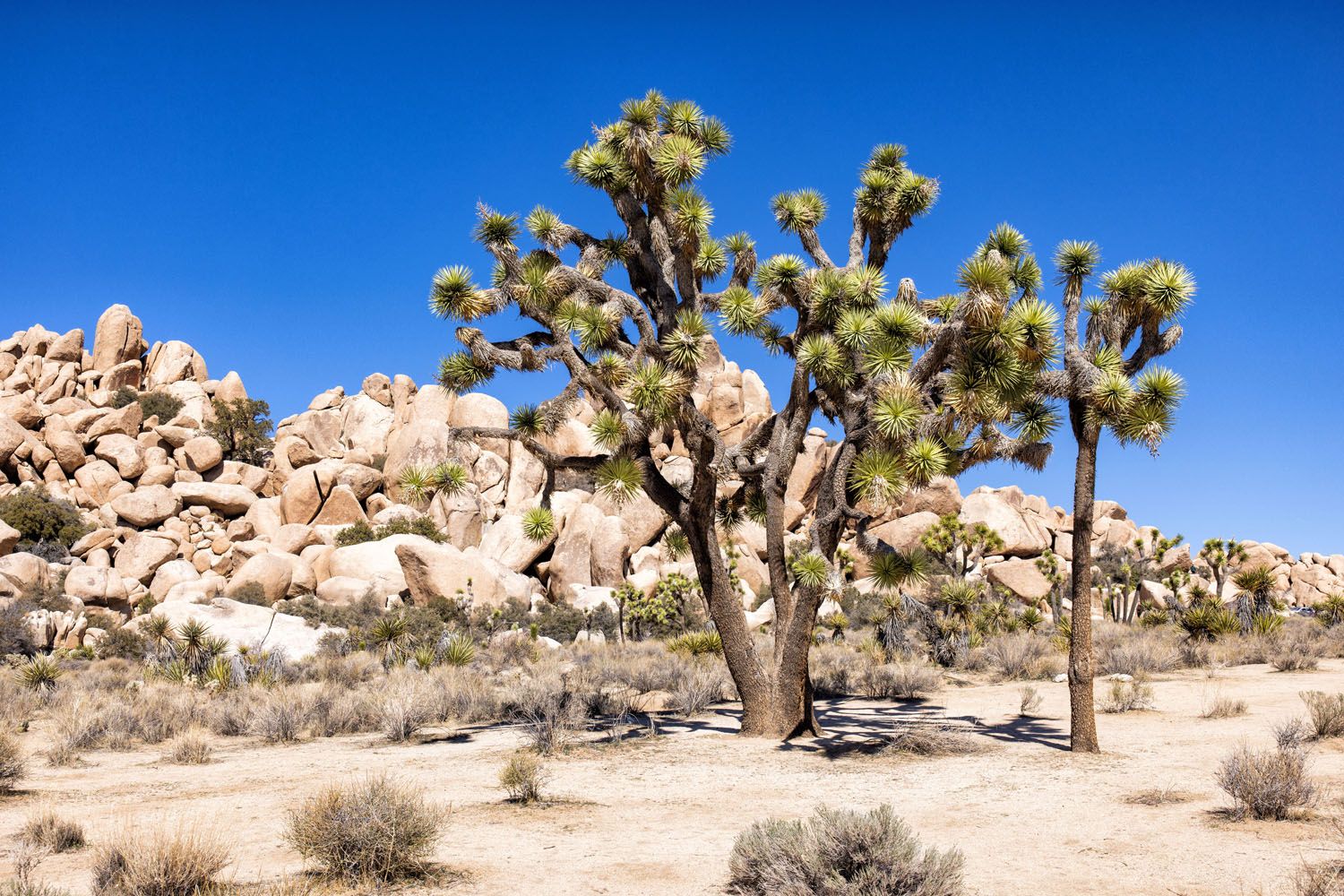
Best Hikes in Joshua Tree

14 Epic Hikes in Joshua Tree National Park (+ Maps & Photos)
One of the best ways to explore Joshua Tree National Park is on foot. Hike to the highest peaks, learn about the Joshua Trees and Cholla cacti on the nature trails, explore hidden slot canyons, and hike to remote oases. In this guide, we share the best hikes in Joshua Tree National Park.
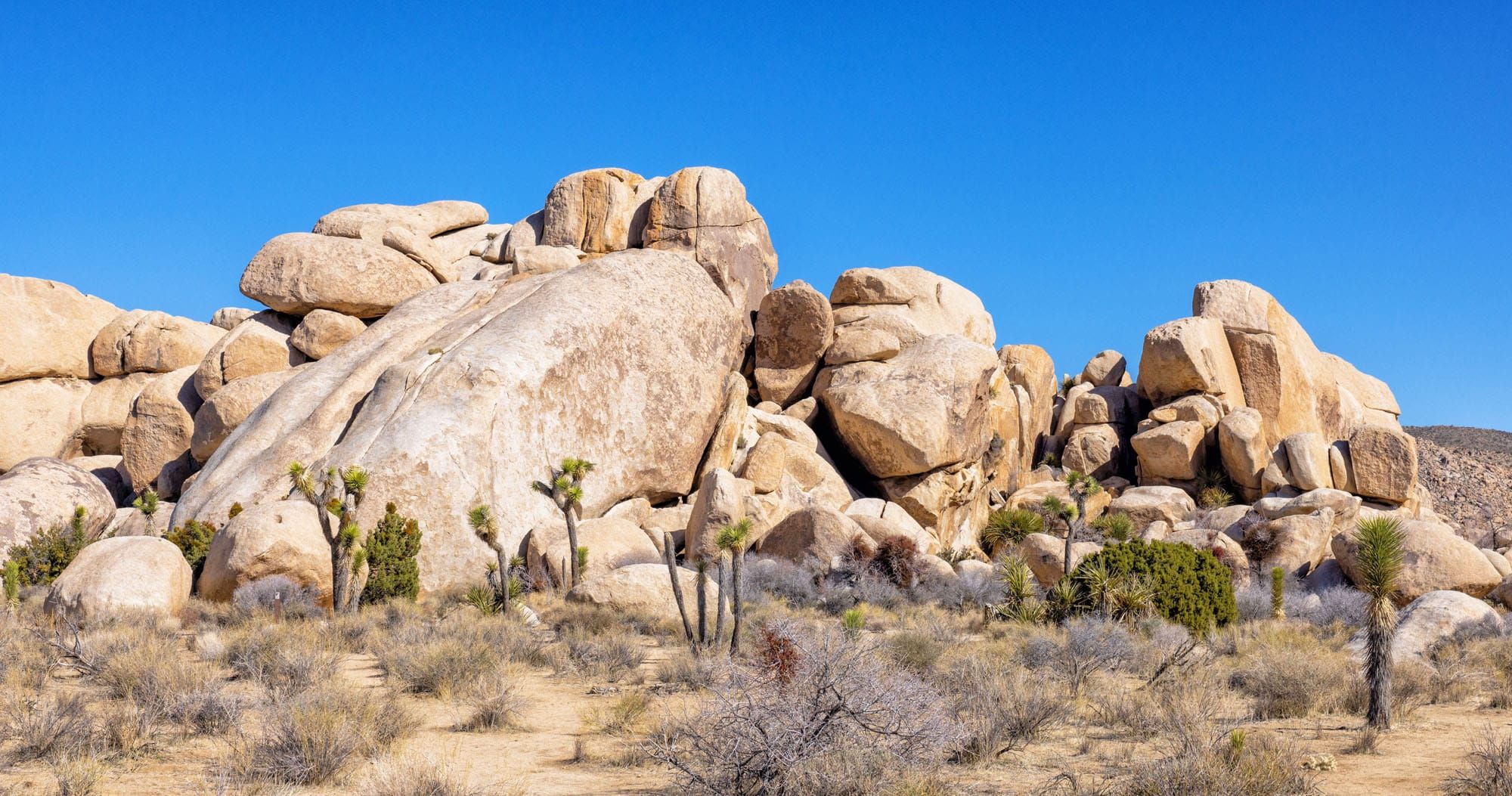
How to Hike the Hall of Horrors | Joshua Tree National Park
The Hall of Horrors is one of the best hikes in Joshua Tree National Park. It’s short, it’s scenic, and adding on the slot canyon is one of the most thrilling experiences in the park. Here’s how to do it.
Skull Rock Trail. This is one of the best, short hikes in the park. For most of the hike, you are traveling past enormous boulders and unique rock formations, such as Skull Rock. Kids, and kids at heart, will also love rock scrambling near Skull Rock.
Hall of Horrors. This short hike was one of our favorite experiences in the park. On this trail, you will hike around two massive piles of boulders with the option to rock scramble and hike through a slot canyon.
Arch Rock Trail. On this trail, you get to see two of the most iconic rock formations in the park: Arch Rock and Heart Rock. The scenery is some of the best in Joshua Tree and you get to do some rock scrambling.
Ryan Mountain. This short, tough hike takes you to a panoramic viewpoint over the heart of Joshua Tree National Park.
Cap Rock Nature Trail. This short but enjoyable nature trail is flat and great for all ages and ability levels. Along the hike, learn about the plants that live and thrive in the Mojave Desert. This is also a great place to photograph the Joshua trees.
Mastodon Peak. This hike starts at Cottonwood Spring and leads up to a panoramic viewpoint over the southern area of the park. You won’t see Joshua trees here, but you do get to see a lot of ocotillo.
Fortynine Palms. Hike out to a hidden oasis and get a great view over Twentynine Palms.
Warren Peak. For panoramic views across the San Bernardino Mountains to San Jacinto and the Santa Rosa Mountains, put this hike on your list. It is located on the western end of the park and it was the quietest trail that we hiked in Joshua Tree National Park.
Barker Dam Nature Trail. When Barker Dam is filled with water, this is a beautiful hike. If it is dry, then skip this hike as there are much better things to do in the park. We recommend getting an update at the visitor center about the water level before taking the time to do this hike.
How Many Days Should You Spend in Joshua Tree?
Ideally, plan on spending a minimum of two days in Joshua Tree National Park. This gives you enough time to visit the highlights, hike a few trails, go rock climbing or take a lesson, and go on the scenic drives.
If you only have one day in Joshua Tree National Park, spend your time on Park Boulevard. Visit Hidden Valley, hike the Hall of Horrors Trail, see Skull Rock and go rock scrambling, enjoy the view from Keys View. If you still have time and energy, visit the Cholla Cactus Garden and/or the Arch Rock Trail.
With two days in Joshua Tree National Park, do everything above on day one. On day two, you can spend more time in the heart of the park, by hiking to Ryan Mountain, driving Geology Tour Road, and rock climbing. Or, venture off the beaten path, by hiking to Warren Peak and driving up to Eureka Peak or by visiting Cottonwood Springs Oasis and hiking to Mastodon Peak.
When to Visit Joshua Tree
Since most of this park sits at or above 4,000 feet, it can be cooler here than you might think. During the winter months, it can be downright cold. Expect daytime highs in the high-50’s to low-60’s and freezing temperatures at night. At the higher elevations, snow is possible.
The best time to visit Joshua Tree National Park is during the spring and fall months, when temperatures are mild. In the spring and fall, daytime highs range from the mid-50’s to the mid-70’s. Rainfall is extremely low during this time.
From late-February through May, it’s possible to see wildflowers and cactus blooming in Joshua Tree National Park (this peaks the months of March and April). This varies from year to year and depends on rain amounts and temperature. During our visit in February, we could see blooms forming on some Joshua trees.
Summers can be hot, but even though Joshua Tree is farther south than Death Valley, it doesn’t get the same scorching temperatures. In July and August, the hottest months of the year, daytime highs approach 100°F with nighttime lows in the low-80’s. Rainfall is low.
Joshua Tree National Park appears in our Best US National Parks Month-By-Month series as a great park to visit in January, February, and November.
12 Best National Parks to Visit in January 2025 (USA)
Planning a trip to the US national parks in January but don’t know which ones to visit? In January, much of the country is cold and covered in snow, but there are plenty of parks you can visit to escape the wintry conditions. In this article, we cover the best national parks to visit in […]
10 Best National Parks to Visit in February 2025 (USA)
Which are the best US national parks to visit in February? The answer to that question depends on whether or not you prefer a warm destination or if you want to explore a winter wonderland. Most of the parks on this list have you escaping the cold, wintry weather, with the exception of one beautiful […]
12 Best National Parks to Visit in November 2025 (USA)
Planning a trip to the US national parks in November and don’t know which ones to visit? The cooler weather in November makes this one of the best times of the year to visit the parks across the southern part of the USA. Road trip through Utah’s Mighty 5, go sledding on sand as white […]
Places to Visit Near Joshua Tree
10 EPIC Things to Do in Mojave National Preserve
With enormous sand dunes, cinder cones, lava beds, and the densest population of Joshua Trees in the world, Mojave National Preserve is home to a wide variety of landscapes. This is a fun place to explore and makes a great addition to a southern California road trip. In this guide, we cover the best things […]
One Perfect Day in Anza-Borrego Desert State Park
Anza-Borrego Desert State Park is a gem of a state park. With desert landscapes, slot canyons and dirt roads to explore, and hidden oases, this is a great place to add to your itinerary, if you will be visiting southern California. In this guide, we cover how to spend one day in Anza-Borrego Desert State […]
Ultimate Guide to The Slot, Anza-Borrego Desert State Park
The Slot is one of the best hikes to do in Anza-Borrego Desert State Park. It’s also one of the most popular, so there are some very important things you need to know before you go. In this guide, we cover the best hiking routes (there is more than one way to do this hike), […]
Joshua Tree Road Trip Itinerary
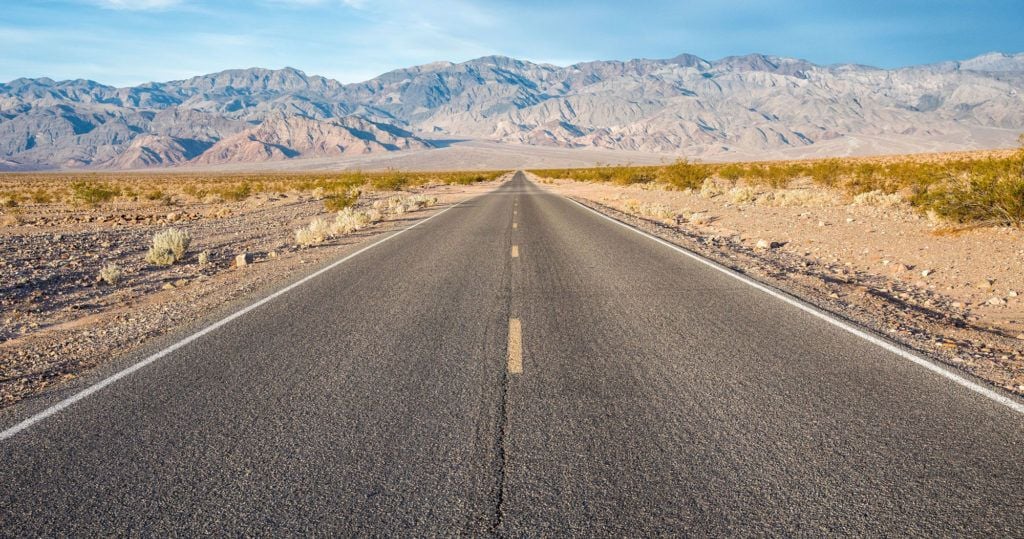
Las Vegas to San Diego 10 Day Road Trip Itinerary
Go on a national park road trip, visiting Death Valley National Park, Joshua Tree National Park and the Mojave National Preserve, which is home to a surprisingly wide variety of landscapes.
This 10 day itinerary connects Las Vegas and San Diego and gives you several options on how to do it, depending on your interests.
Joshua Tree National Park Map
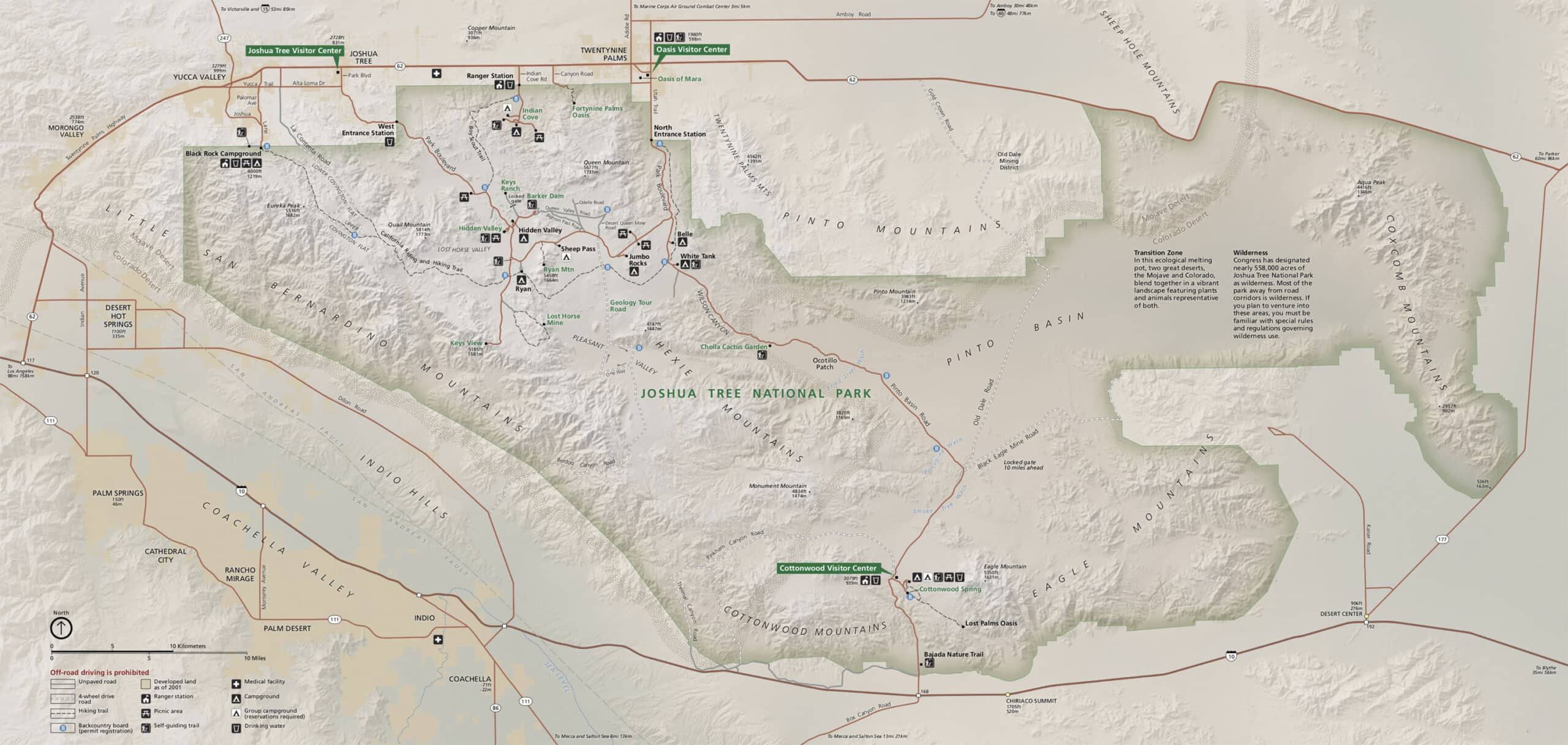
US National Parks List
In our US National Parks List, get information on all of the US national parks, including interesting facts, the most and least visited national parks, and a FREE printable national parks checklist with map.
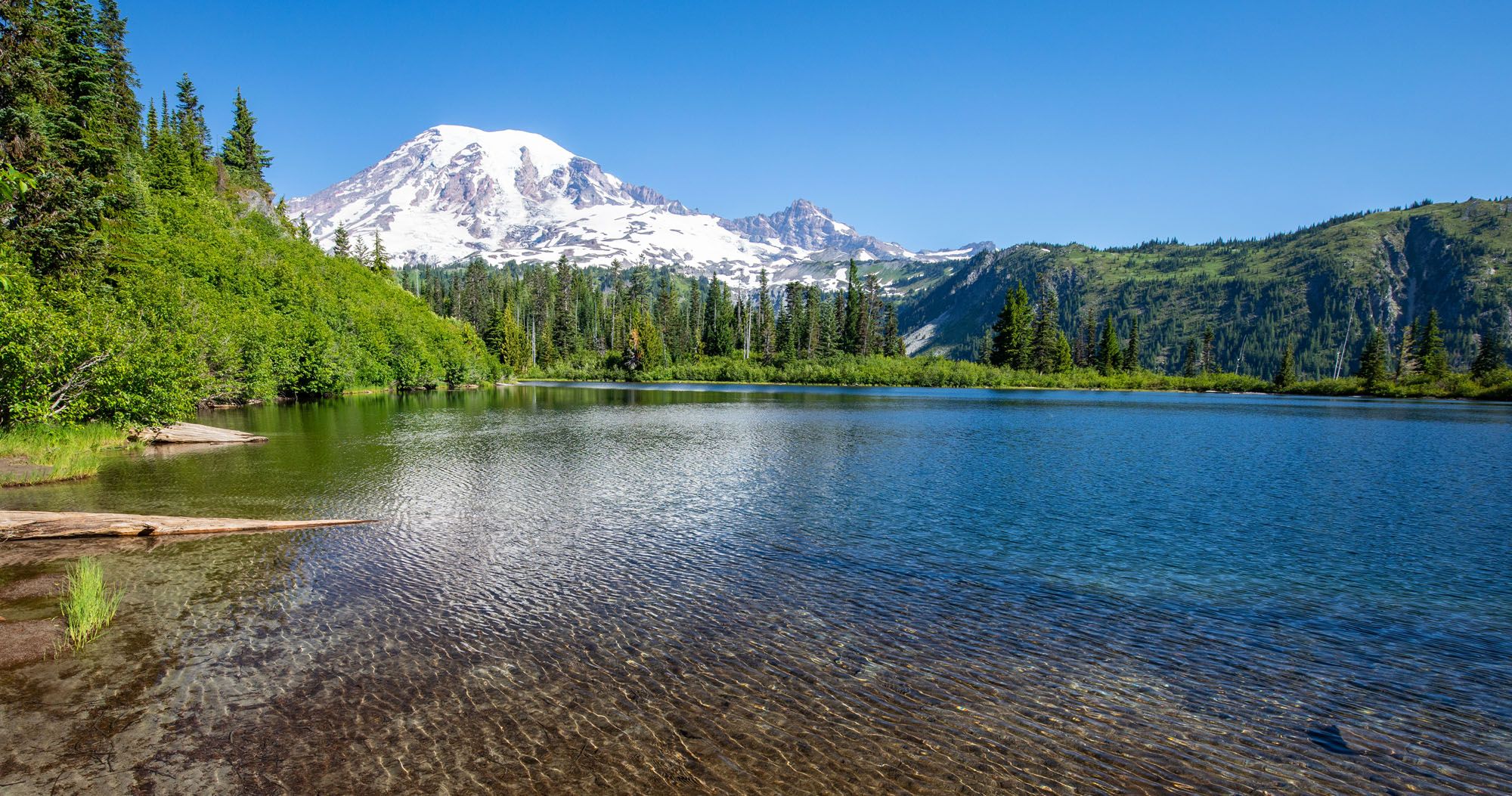
Ultimate US National Parks List for 2025 (+ Printable Checklist)
